WORLD TRADE ORGANIZATION
Home | About WTO | News & events | Trade topics | WTO membership | Documents & resources | External relations
Contact us | Site map | A-Z | Search
- trade topics
- article 27.3b
TRIPS : ISSUES

Article 27.3b, traditional knowledge, biodiversity
The TRIPS Agreement requires a review of Article 27.3(b) which deals with patentability or non-patentability of plant and animal inventions, and the protection of plant varieties.
Paragraph 19 of the 2001 Doha Declaration has broadened the discussion. It says the TRIPS Council should also look at the relationship between the TRIPS Agreement and the UN Convention on Biological Diversity, the protection of traditional knowledge and folklore.
It adds that the TRIPS Councils work on these topics is to be guided by the TRIPS Agreements objectives (Article 7) and principles (Article 8), and must take development issues fully into account.
> Back to TRIPS issues
TRIPS news
News about the TRIPS Council and intellectual property in the WTO, prepared for non-specialists.
Briefing
Background and the current situation on Article 27.3(b), traditional knowledge and biodiversity
Secretariat documents
Summaries of issues raised and points made:
- The TRIPS Agreement and Convention on Biological Diversity. Paper IP/C/W/368/Rev.1, revised 8 February 2006 > Download: 78 pages in Word 595KB, pdf 158KB IP/C/W/368/Rev.1/Corr.1, 9 March 2006 > Download: 12 pages in Word 258KB, pdf 69KB
- Review of Article 27.3(b). Paper IP/C/W/369/Rev.1, revised 9 March 2006 > Download: 36 pages in Word 479KB, pdf 233KB
- The protection of traditional knowledge and folklore. Paper IP/C/W/370/Rev.1, revised 9 March 2006 > Download: 29 pages in Word 370KB, pdf 183KB
Replies to questionnaire in implementing Art.27.3(b):
- Review of the Provisions of Article 27.3(b): Illustrative List of Questions Prepared by the Secretariat Revision. Paper IP/C/W/273/Rev.1, 18 February 2003 > Download: 56 pages in Word 296KB, pdf 320KB
Documents
Documents circulated under the 2001 mandate of the Doha Development Agenda
(Document numbers are hyperlinks to Word files in WTO Documents Online . Left click to open the documents in a new window; right click to download the files directly.)
More documents:
Search Documents Online for all documents on Article 27.3b, traditional knowledge and biodiversity since 1995 These links open a new window: allow a moment for the results to appear.
- All documents (Document code varies) > search > help
You can perform more sophisticated searches from the Documents Online search facility (opens in new window) by defining multiple search criteria such as document symbol (i.e. code number), full text search or document date.
Browse Subjects
- Agreement on Trade-Related Aspects of Intellectual Property Rights (1994 April 15)">(1994 April 15)
- Convention on Biological Diversity (1992 June 5)">(1992 June 5)
- Cartagena Protocol on Biosafety.
- Biodiversity conservation Law and legislation">Law and legislation Law and legislation > Developing countries.">Developing countries.
- Biodiversity.
- Intellectual property.
- Plant varieties Protection.">Protection.
- BIODIVERSITY
- TRIPS (AGREEMENT ON TRADE-RELATED ASPECTS OF INTELLECTUAL PROPERTY RIGHTS)
- INDIGENOUS PEOPLES
- TRADITIONAL KNOWLEDGE
- Even more »
Account Options

- Try the new Google Books
- Advanced Book Search
- Barnes&Noble.com
- Books-A-Million
- Find in a library
- All sellers »

Get Textbooks on Google Play
Rent and save from the world's largest eBookstore. Read, highlight, and take notes, across web, tablet, and phone.
Go to Google Play Now »
From inside the book
Other editions - view all, common terms and phrases, bibliographic information.
Article 27(3)(b) TRIPS and Plant Variety Protection in Developing Countries
Cite this chapter.

- Christoph Antons 8
Part of the book series: MPI Studies on Intellectual Property and Competition Law ((MSIP,volume 25))
1541 Accesses
4 Citations
In comparison with industrialised countries, agriculture in developing countries accounts for a substantial share of GDP and involves a substantial sector of small-holders and traditional agriculturalists. In view of these differences, the biotechnology clause of Article 27.3.b TRIPS with its requirement of plant variety protection either by patents or an effective sui generis system or a combination of the two has been controversial. However, developing countries have made surprisingly little use of the freedom to design their own systems in this field. Instead, there has been a surge in UPOV membership among developing countries and some have gone as far as introducing patent protection for plant varieties. Such countries now have to consider the same exclusions and exceptions to patenting that are normally discussed in countries with much more advanced biotechnology industries. The chapter examines the scope for the use of orde public considerations under Article 27.2 TRIPS, of exceptions for research and experimental purposes under Article 30 TRIPS, compulsory licensing under Article 31 TRIPS as well as the advantages of a specific breeding exemption and it briefly comments on the various sui generis options. While liberal interpretations of the TRIPS exceptions remain possible, the chapter concludes that the majority of developing countries will be better off in more creatively using the freedom to develop sui generis systems suitable for their local conditions rather than struggling to introduce TRIPS conform ‘limited exceptions’ to patent protection for plant varieties.
Prof. Dr. Christoph Antons is Professor at Deakin University, Melbourne, Affiliated Research Fellow at the Max Planck Institute for Innovation and Competition, Munich, Chief Investigator at the ARC Centre of Excellence for Creative Industries and Innovation and Senior Fellow at the Center for Development Research, University of Bonn.
This is a preview of subscription content, log in via an institution to check access.
Access this chapter
- Available as PDF
- Read on any device
- Instant download
- Own it forever
- Available as EPUB and PDF
- Compact, lightweight edition
- Dispatched in 3 to 5 business days
- Free shipping worldwide - see info
- Durable hardcover edition
Tax calculation will be finalised at checkout
Purchases are for personal use only
Institutional subscriptions
E.g. P. Drahos & J. Braithwaite (2002), Information Feudalism: Who Owns the Knowledge Economy?; S.K. Sell (2003), Private Power, Public Law: The Globalization of Intellectual Property Rights.
See for example the discussion of the impact of Article 27.1 TRIPS in UNCTAD-ICTSD (2005), Resource Book on TRIPS and Development, pp. 363-367.
C.M. Correa (2012), TRIPS-Related Patent Flexibilities and Food Security: Options for Developing Countries, p. 3.
M. Llewelyn (2003), Which Rules in World Trade Law – Patents or Plant Variety Protection?, in T. Cottier & P.C. Mavroidis (Eds.), Intellectual Property: Trade, Competition and Sustainable Development, p. 306.
World Bank World Development Indicators: Data Indicators Agriculture, value added (% of GDP), available at: http://data.worldbank.org/indicator/NV.AGR.TOTL.ZS (accessed 24 March 2014).
C.M. Correa (2012), TRIPS-Related Patent Flexibilities and Food Security: Options for Developing Countries, p. 2.
H.M. Haugen, M.R. Muller & S.M. Narashiman (2011), Food Security and Intellectual Property Rights: Finding the Linkages, in T. Wong & G. Dutfield (Eds.), Intellectual Property and Human Development: Current Trends and Future Scenarios, pp. 103-138.
World Bank World Development Indicators: Data Indicators Rural population (% of total population), available at: http://data.worldbank.org/indicator/SP.RUR.TOTL.ZS (accessed 24 March 2014).
C. Wittayapak & P. Vandergeest (2010), The Politics of Decentralization: Natural Resource Management in Asia.
E.g. S. Smeltzer (2008), The Message is the Market: Selling Biotechnology and Nation in Malaysia, in J. Nevins & N.L. Peluso (Eds.), Taking Southeast Asia to Market: Commodities, Nature, and People in the Neoliberal Age, pp. 191-205.
See www.upov.int/members/en (accessed 25 September 2014).
See www.upov.int/members/en/observers.html (accessed 25 September 2014).
UNCTAD-ICTSD (2005), Resource Book on TRIPS and Development, p. 391.
D. Gervais (2008), The TRIPS Agreement: Drafting History and Analysis, pp. 361-372.
D.B. Barbosa & K. Grau-Kuntz (2010), Exclusions from Patentable Subject Matter and Exceptions and Limitations to the Rights: Biotechnology, WIPO SCP/15/3, p. 19, note 43.
On the different views in the Council for TRIPS deliberations during the review, see P. Roffe (2008), Bringing Minimum Intellectual Property Standards into Agriculture: The Agreement on Trade-Related Aspects of Intellectual Property Rights (TRIPS), in G. Tansey & T. Rajotte (Eds.), The Future Control of Food, pp. 63-64.
D. Gervais (2008), The TRIPS Agreement: Drafting History and Analysis, p. 353; UNCTAD-ICTSD (2005), Resource Book on TRIPS and Development, p. 394; M. Llewelyn (2003), Which Rules in World Trade Law – Patents or Plant Variety Protection?, in T. Cottier & P.C. Mavroidis (Eds.), Intellectual Property: Trade, Competition and Sustainable Development, pp. 308-309; K. Aoki (2008), Seed Wars: Controversies and Cases on Plant Genetic Resources and Intellectual Property, p. 82, note 101; G. van Overwalle (2008), Biotechnology and Patents: Global Standards, European Approaches and National Accents, in D. Würger & T. Cottier (Eds.), Genetic Engineering and the World Trade System, p. 80.
H.M. Haugen, M.R. Muller & S.M. Narashiman (2011), Food Security and Intellectual Property Rights: Finding the Linkages, in T. Wong & G. Dutfield (Eds.), Intellectual Property and Human Development: Current Trends and Future Scenarios, p. 120.
S. Ragavan & J. Mayer (2007), Has India Addressed Its Farmers Woes? A Story of Plant Protection Issues, 20 Geo. Int’l Envtl. L. Rev. 2007, 101.
D.B. Barbosa & K. Grau-Kuntz (2010), Exclusions from Patentable Subject Matter and Exceptions and Limitations to the Rights: Biotechnology, WIPO SCP/15/3, p. 39; S. Ragavan & J. Mayer (2007), Has India Addressed Its Farmers Woes? A Story of Plant Protection Issues, 20 Geo. Int’l Envtl. L. Rev. 2007, 103.
UNCTAD-ICTSD (2005), Resource Book on TRIPS and Development, p. 353.
C.M. Correa (2012), TRIPS-Related Patent Flexibilities and Food Security: Options for Developing Countries, p. 6.
D.B. Barbosa & K. Grau-Kuntz (2010), Exclusions from Patentable Subject Matter and Exceptions and Limitations to the Rights: Biotechnology, WIPO SCP/15/3, pp. 20-24.
L. Bently (2011), Exclusions from Patentability and Exceptions to Patentees’ Rights: Taking Exceptions Seriously, 64 CLP 2011, 334.
R. Kanniah & C. Antons (2012), Plant Variety Protection and Traditional Agricultural Knowledge in Southeast Asia, 13 Australian J. Asian L. 2010, 3.
W.L. Ng-Loy (2015), IP and FTAs of Singapore: Ten Years On, in C. Antons & R.M. Hilty (Eds.), Free Trade Agreements and Intellectual Property in the Asia-Pacific Region.
C.M. Correa (2012), TRIPS-Related Patent Flexibilities and Food Security: Options for Developing Countries, p. 4; D.B. Barbosa & K. Grau-Kuntz (2010), Exclusions from Patentable Subject Matter and Exceptions and Limitations to the Rights: Biotechnology, WIPO SCP/15/3, p. 32.
C.M. Correa (2012), TRIPS-Related Patent Flexibilities and Food Security: Options for Developing Countries, pp. 5-6; see also H.M. Haugen (2007), The Right to Food and the TRIPS Agreement: With a Particular Emphasis on Developing Countries’ Measures for Food Production and Distribution, pp. 228-229.
Ibid., p. 233, fn. 84.
Ibid., p. 230.
G. van Overwalle (2008), Biotechnology and Patents: Global Standards, European Approaches and National Accents, in D. Würger & T. Cottier (Eds.), Genetic Engineering and the World Trade System, pp. 89-91; N. Louwaars et al. (2009), Breeding Business: The Future of Plant Breeding in the Light of Developments in Patent Rights and Plant Breeder’s Rights, pp. 15-16; P. van der Kooij (2010), Towards a Breeder’s Exemption in Patent Law?, 32 EIPR 2010, 546-547.
K. Aoki (2008), Seed Wars: Controversies and Cases on Plant Genetic Resources and Intellectual Property, pp. 30-34.
Diamond v. Chakrabarty, 447 U.S. 303 (1980).
N. Louwaars et al. (2009), Breeding Business: The Future of Plant Breeding in the Light of Developments in Patent Rights and Plant Breeder’s Rights, p. 29; P. van der Kooij (2010), Towards a Breeder’s Exemption in Patent Law?, 32 EIPR 2010, 549; C.M. Correa (2012), TRIPS-Related Patent Flexibilities and Food Security: Options for Developing Countries, p. 5; M. Rimmer (2013), Patent-Busting: The Public Patent Foundation, Gene Patents and the Seed Wars, in C. Lawson & J. Sanderson (Eds.), The Intellectual Property and Food Project: From Rewarding Innovation and Creation to Feeding the World.
R.C. Dreyfuss (2009), Fostering Dynamic Innovation, Development and Trade: Intellectual Property as a Case Study in Global Administrative Law, Acta Juridica 2009, 258-259.
C.M. Correa (2012), TRIPS-Related Patent Flexibilities and Food Security: Options for Developing Countries; C.M. Correa (2005), The International Dimension of the Research Exception; C. Garrison (2006), Exceptions to Patent Rights in Developing Countries, UNCTAD-ICTSD Issue Paper No. 17; G. Dinwoodie & R. Dreyfuss (2007), Diversifying Without Discriminating: Complying with the Mandates of the TRIPS Agreement, 13 Mich. Telecomm. Tech. L. Rev. 2007, 445; H.M. Haugen (2007), The Right to Food and the TRIPS Agreement: With a Particular Emphasis on Developing Countries’ Measures for Food Production and Distribution; H.M. Haugen (2009), Human Rights and TRIPS Exclusion and Exception Provisions, 11 J. W. Intell. Prop. 2009, 345; H.M. Haugen, M.R. Muller & S.M. Narashiman (2011), Food Security and Intellectual Property Rights: Finding the Linkages, in T. Wong & G. Dutfield (Eds.), Intellectual Property and Human Development: Current Trends and Future Scenarios.
K.J. Strandburg (2009), Evolving Innovation Paradigms and the Global Intellectual Property Regime, 41 Conn. L. Rev. 2009, 861-920; C. Dent (2011), The TRIPS Agreement and an Experimental Use Exception for ‘Research Tools’, 44 Australian Econ. Rev. 2011, 73-78.
C.M. Correa (2012), TRIPS-Related Patent Flexibilities and Food Security: Options for Developing Countries, p. 8.
S. Hubicki & B. Sherman (2005), Terminator Genes as “Technical” Protection Measures for Patents?, in C. Heath & A. Kamperman Sanders (Eds.), New Frontiers of Intellectual Property Law: IP and Cultural Heritage, Geographical Indications, Enforcement and Overprotection.
H.M. Haugen (2009), Human Rights and TRIPS Exclusion and Exception Provisions, 11 J. W. Intell. Prop. 2009, 349-350.
G. van Overwalle (2008), Biotechnology and Patents: Global Standards, European Approaches and National Accents, in D. Würger & T. Cottier (Eds.), Genetic Engineering and the World Trade System, p. 81.
M. Llewelyn (2003), Which Rules in World Trade Law – Patents or Plant Variety Protection?, in T. Cottier & P.C. Mavroidis (Eds.), Intellectual Property: Trade, Competition and Sustainable Development, p. 307.
H.M. Haugen (2009), Human Rights and TRIPS Exclusion and Exception Provisions, 11 J. W. Intell. Prop. 2009, 345.
J. Curci (2010), The Protection of Biodiversity and Traditional Knowledge in International Law of Intellectual Property, pp. 234-235.
P. Drahos (2010), The Global Governance of Knowledge: Patent Offices and their Clients.
C. Arup (2008), The World Trade Organization Knowledge Agreements, p. 392; see also R.C. Dreyfuss (2009), Fostering Dynamic Innovation, Development and Trade: Intellectual Property as a Case Study in Global Administrative Law, Acta Juridica 2009, 252.
L. Bently (2011), Exclusions from Patentability and Exceptions to Patentees’ Rights: Taking Exceptions Seriously, 64 CLP 2011, 329, 338-341.
C.M. Correa (2005), The International Dimension of the Research Exception, pp. 7-8.
Ibid., p. 6, note 4.
Ibid., p. 8.
S.J.R. Bostyn (2013), Patentability of Plants: At the Crossroads between Monopolizing Nature and Protecting Technological Innovation?, 16 J. W. Intell. Prop. 2013, 132.
V. Prifti (2013), The Breeding Exemption in Patent Law: Analysis of Compliance with Article 30 of the TRIPS Agreement, 16 J. W. Intell. Prop. 2013, 218-219.
K.J. Strandburg (2004), What Does the Public Get? Experimental Use and the Patent Bargain, Wis. L. Rev. 2004, 122.
G. van Overwalle (2006), The Implementation of the Biotechnology Directive and its After-Effects: The Introduction of a New Research Exemption and a Compulsory Licence for Public Health, 37 IIC 2006, 907.
C.M. Correa (2005), The International Dimension of the Research Exception, p. 23; C. Garrison (2006), Exceptions to Patent Rights in Developing Countries, UNCTAD-ICTSD Issue Paper No. 17, pp. 4-5; E. Misati & K. Adachi (2010), The Research and Experimentation Exceptions in Patent Law: Jurisdictional Variations and the WIPO Development Agenda, UNCTAD-ICTSD Policy Brief No. 7, pp. 3-6.
Ibid., pp. 4, 6.
V. Prifti (2013), The Breeding Exemption in Patent Law: Analysis of Compliance with Article 30 of the TRIPS Agreement, 16 J. W. Intell. Prop. 2013, 219.
Ibid., 236, note 4, mentioning the pharmaceutical, biofuel, chemical and cosmetics industry.
See the overview in C.M. Correa (2005), The International Dimension of the Research Exception, pp. 34-66.
Ibid., p. 31.
W.R. Cornish (1998), Experimental Use of Patented Inventions in European Community States, 29 IIC 1998, 735; E. Misati & K. Adachi (2010), The Research and Experimentation Exceptions in Patent Law: Jurisdictional Variations and the WIPO Development Agenda, UNCTAD-ICTSD Policy Brief No. 7, p. 3.
UNCTAD-ICTSD (2005), Resource Book on TRIPS and Development, p. 443.
N. Louwaars et al. (2009), Breeding Business: The Future of Plant Breeding in the Light of Developments in Patent Rights and Plant Breeder’s Rights, p. 17; S.J.R. Bostyn (2013), Patentability of Plants: At the Crossroads between Monopolizing Nature and Protecting Technological Innovation?, 16 J. W. Intell. Prop. 2013, 133-134. See also the list of countries in WIPO (2010), Patent Related Flexibilities in the Multilateral Legal Framework and their Legislative Implementation at the National and Regional Levels, WIPO Doc. CDIP/5/4 Rev., p. 21.
C. Dent (2011), The TRIPS Agreement and an Experimental Use Exception for ‘Research Tools’, 44 Australian Econ. Rev. 2011, 76-77.
H. Grosse Ruse-Khan (2011), Assessing the Need for a General Public Interest Exception in the TRIPS Agreement, in A. Kur & M. Levin (Eds.), Intellectual Property Rights in a Fair World Trade System: Proposals for Reform of TRIPS, p. 183; A. Kur (2011), Limitations and Exceptions under the Three-Step Test – How much Room to Walk the Middle Ground?, in A. Kur & M. Levin (Eds.), Intellectual Property Rights in a Fair World Trade System: Proposals for Reform of TRIPS, p. 227.
R.C. Dreyfuss (2009), Fostering Dynamic Innovation, Development and Trade: Intellectual Property as a Case Study in Global Administrative Law, Acta Juridica 2009, 252-255.
A. Kur (2011), Limitations and Exceptions under the Three-Step Test – How much Room to Walk the Middle Ground?, in A. Kur & M. Levin (Eds.), Intellectual Property Rights in a Fair World Trade System: Proposals for Reform of TRIPS, pp. 236-237, 239.
C. Garrison (2006), Exceptions to Patent Rights in Developing Countries, UNCTAD-ICTSD Issue Paper No. 17, pp. 41-42.
C.M. Correa (2005), The International Dimension of the Research Exception, p. 10.
A. Kur (2011), Limitations and Exceptions under the Three-Step Test – How much Room to Walk the Middle Ground?, in A. Kur & M. Levin (Eds.), Intellectual Property Rights in a Fair World Trade System: Proposals for Reform of TRIPS, p. 240.
L. Bently (2011), Exclusions from Patentability and Exceptions to Patentees’ Rights: Taking Exceptions Seriously, 64 CLP 2011, 346-347.
A. Kur (2011), Limitations and Exceptions under the Three-Step Test – How much Room to Walk the Middle Ground?, in A. Kur & M. Levin (Eds.), Intellectual Property Rights in a Fair World Trade System: Proposals for Reform of TRIPS, p. 238.
C. Geiger, J. Griffiths & R.M. Hilty (2008), Declaration on a Balanced Interpretation of the ‘Three-Step Test’ in Copyright Law, 39 IIC 2008, 709.
H. Grosse Ruse-Khan (2011), Assessing the Need for a General Public Interest Exception in the TRIPS Agreement, in A. Kur & M. Levin (Eds.), Intellectual Property Rights in a Fair World Trade System: Proposals for Reform of TRIPS; A. Kur (2011), Limitations and Exceptions under the Three-Step Test – How much Room to Walk the Middle Ground?, in A. Kur & M. Levin (Eds.), Intellectual Property Rights in a Fair World Trade System: Proposals for Reform of TRIPS.
A. Kur (2011), Limitations and Exceptions under the Three-Step Test – How much Room to Walk the Middle Ground?, in A. Kur & M. Levin (Eds.), Intellectual Property Rights in a Fair World Trade System: Proposals for Reform of TRIPS, p. 249.
H.M. Haugen (2007), The Right to Food and the TRIPS Agreement: With a Particular Emphasis on Developing Countries’ Measures for Food Production and Distribution, p. 243.
C.M. Correa (2005), The International Dimension of the Research Exception, p. 16.
V. Prifti (2013), The Breeding Exemption in Patent Law: Analysis of Compliance with Article 30 of the TRIPS Agreement, 16 J. W. Intell. Prop. 2013, 225.
C.M. Correa (2005), The International Dimension of the Research Exception, pp. 34-66.
See for example the provisions in Albania, Argentina, Bahrain, Bolivia, Kazakhstan, Nicaragua and others. See also the countries listed in WIPO (2010), Patent Related Flexibilities in the Multilateral Legal Framework and their Legislative Implementation at the National and Regional Levels, WIPO Doc. CDIP/5/4 Rev., p. 21.
UNCTAD-ICTSD (2005), Resource Book on TRIPS and Development, p. 437.
M.R. Dove (2000), The Life-Cycle of Indigenous Knowledge, and the Case of Natural Rubber Production, in R. Ellen, P. Parkes & A. Bicker (Eds.), Indigenous Environmental Knowledge and its Transformations: Critical Anthropological Perspectives, p. 215.
M.R. Dove (2012), The Banana Tree at the Gate: A History of Marginal Peoples and Global Markets in Borneo, p. 201.
A. Kur (2011), Limitations and Exceptions under the Three-Step Test – How much Room to Walk the Middle Ground?, in A. Kur & M. Levin (Eds.), Intellectual Property Rights in a Fair World Trade System: Proposals for Reform of TRIPS.
C.M. Correa (2005), The International Dimension of the Research Exception.
See also P. van der Kooij (2010), Towards a Breeder’s Exemption in Patent Law?, 32 EIPR 2010, 549.
C. Dent (2011), The TRIPS Agreement and an Experimental Use Exception for ‘Research Tools’, 44 Australian Econ. Rev. 77; K.J. Strandburg (2004), What Does the Public Get? Experimental Use and the Patent Bargain, Wis. L. Rev. 2004, 138-146.
C. Dent et al. (2006), Research Use of Patented Knowledge: A Review, STI Working Paper 2006/2, pp. 38-39.
C.M. Correa (2012), TRIPS-Related Patent Flexibilities and Food Security: Options for Developing Countries, p. 15.
Directive 98/44/EC of the European Parliament and of the Council of 6 July 1998 on the legal protection of biotechnological inventions; P. van der Kooij (2010), Towards a Breeder’s Exemption in Patent Law?, 32 EIPR 2010, 547-548.
H. Grosse Ruse-Khan (2011), Assessing the Need for a General Public Interest Exception in the TRIPS Agreement, in A. Kur & M. Levin (Eds.), Intellectual Property Rights in a Fair World Trade System: Proposals for Reform of TRIPS, p. 184.
J.J. Fox (2014), Fast Breeding Insect is Devastating Java’s Rice – Thanks to Pesticides, Jakarta Globe of 7 March 2014.
N. Louwaars et al. (2009), Breeding Business: The Future of Plant Breeding in the Light of Developments in Patent Rights and Plant Breeder’s Rights, p. 53; P. van der Kooij (2010), Towards a Breeder’s Exemption in Patent Law?, 32 EIPR 2010, 545.
V. Prifti (2013), The Breeding Exemption in Patent Law: Analysis of Compliance with Article 30 of the TRIPS Agreement, 16 J. W. Intell. Prop. 2013, 222.
Ibid., 226; L. Bently (2011), Exclusions from Patentability and Exceptions to Patentees’ Rights: Taking Exceptions Seriously, 64 CLP 2011, 343.
See also P. van der Kooij (2010), Towards a Breeder’s Exemption in Patent Law?, 32 EIPR 2010, 552.
V. Prifti (2013), The Breeding Exemption in Patent Law: Analysis of Compliance with Article 30 of the TRIPS Agreement, 16 J. W. Intell. Prop. 2013, 235.
P. van der Kooij (2010), Towards a Breeder’s Exemption in Patent Law?, 32 EIPR 2010, 545.
C.G. Trojan (2012), Problem-solving Approaches to the Issue of the Overlap between Patent Law and Breeders’ Rights in the Plant Breeding Sector.
P. van der Kooij (2010), Towards a Breeder’s Exemption in Patent Law?, 32 EIPR 2010, 550.
For a detailed discussion see D. Leskien & M. Flitner (1997), Intellectual Property Rights and Plant Genetic Resources: Options for a Sui Generis System, IPGRI Issues in Genetic Resources No. 6; C.M. Correa (2000), Options for the Implementation of Farmers’ Rights at the National Level, S. Ctr. Working Paper No. 8.
R. Kanniah & C. Antons (2012), Plant Variety Protection and Traditional Agricultural Knowledge in Southeast Asia, 13 Australian J. Asian L. 2012, 12-13; E.O. Awuku (2008), Intellectual Property Rights, Biotechnology and Development: African Perspectives, in D. Würger & T. Cottier (Eds.), Genetic Engineering and the World Trade System, p. 115; T. Jaeger (2015), The EU Approach to IP Protection in Partnership Agreements, in C. Antons & R.M. Hilty (Eds.), Intellectual Property and Free Trade Agreements in the Asia-Pacific Region.
C. Antons (2010), Sui Generis Protection for Plant Varieties and Traditional Knowledge in Biodiversity and Agriculture: The International Framework and National Approaches in the Philippines and India, 6 Ind. J.L. Tech. 2010, 95, 103; B. Tobin (2013), Open Access Seeds and Breeds: The Role of the Commons in Protecting Farmers’ and Livestock Keeper’s Rights and Food Security, in C. Lawson & J. Sanderson (Eds.), The Intellectual Property and Food Project: From Rewarding Innovation and Creation to Feeding the World, pp. 86-90.
R. Andersen & T. Winge (2013), Realising Farmers’ Rights to Crop Genetic Resources: Success Stories and Best Practices.
T. Winge, R. Andersen & A. Ramanna Pathak (2013), Combining Farmers’ Rights and Plant Variety Protection in Indian Law, in R. Andersen & T. Winge (Eds.), Realising Farmers’ Rights to Crop Genetic Resources: Success Stories and Best Practices; S. Ragavan & J. Mayer (2007), Has India Addressed Its Farmers Woes? A Story of Plant Protection Issues, 20 Geo. Int’l Envtl. L. Rev. 2007, 97.
R. Sagar (2005), Intellectual Property, Benefit-Sharing and Traditional Knowledge: How Effective is the Indian Biological Diversity Act, 2002?, 8 J. W. Intell. Prop. 2005, 383; N.S. Gopalakrishnan (2002), Protection of Traditional Knowledge: The Need for a Sui Generis Law in India, 5 J. W. Intell. Prop. 2002, 725; C. Antons (2007), Sui Generis Protection for Plant Varieties and Traditional Agricultural Knowledge: The Example of India, 29 EIPR 2007, 480; C. Antons (2010), Sui Generis Protection for Plant Varieties and Traditional Knowledge in Biodiversity and Agriculture: The International Framework and National Approaches in the Philippines and India, 6 Ind. J.L. Tech. 2010, 89; B. Tobin (2013), Open Access Seeds and Breeds: The Role of the Commons in Protecting Farmers’ and Livestock Keeper’s Rights and Food Security, in C. Lawson & J. Sanderson (Eds.), The Intellectual Property and Food Project: From Rewarding Innovation and Creation to Feeding the World; R. Kanniah & C. Antons (2012), Plant Variety Protection and Traditional Agricultural Knowledge in Southeast Asia, 13 Australian J. Asian L. 2012, 1.
See the contributions in J.P. Brosius, A. Lowenhaupt Tsing & C. Zerner (2005), Communities and Conservation: Histories and Politics of Community-Based Natural Resource Management; C. Wittayapak & P. Vandergeest (2010), The Politics of Decentralization: Natural Resource Management in Asia.
E. Ostrom & C. Hess (2007), A Framework for Analyzing the Knowledge Commons, in C. Hess & E. Ostrom (Eds.), Understanding Knowledge as a Commons: From Theory to Practice.
P. Vandergeest & C. Wittayapak (2010), Decentralization and Politics, in C. Wittayapak & P. Vandergeest (Eds.), The Politics of Decentralization: Natural Resource Management in Asia.
L.R. Helfer & G.W. Austin (2011), Human Rights and Intellectual Property: Mapping the Global Interface, p. 388.
See also C.M. Correa (2012), TRIPS-Related Patent Flexibilities and Food Security: Options for Developing Countries, p. 13.
L.R. Helfer & G.W. Austin (2011), Human Rights and Intellectual Property: Mapping the Global Interface, p. 388, quoting J. Watal (2000), Intellectual Property Rights in the WTO and Developing Countries.
Andersen, R. & Winge, T. (2013), Realising Farmers’ Rights to Crop Genetic Resources: Success Stories and Best Practices, Abingdon (UK): Routledge
Google Scholar
Antons, C. (2007), Sui Generis Protection for Plant Varieties and Traditional Agricultural Knowledge: The Example of India, 29 EIPR 2007, 480, London: Sweet & Maxwell
Antons, C. (2010), Sui Generis Protection for Plant Varieties and Traditional Knowledge in Biodiversity and Agriculture: The International Framework and National Approaches in the Philippines and India, 6 Ind. J.L. Tech. 2010, 89, Bangalore: National Law School of India University
Aoki, K. (2008), Seed Wars: Controversies and Cases on Plant Genetic Resources and Intellectual Property, Durham, North Carolina: Carolina Academic Press
Arup, C. (2008), The World Trade Organization Knowledge Agreements, 2 nd ed., Cambridge: Cambridge University Press
Awuku, E.O. (2008), Intellectual Property Rights, Biotechnology and Development: African Perspectives, in D. Würger & T. Cottier (Eds.), Genetic Engineering and the World Trade System, pp. 109-117, Cambridge: Cambridge University Press
Barbosa, D.B. & Grau-Kuntz, K. (2010), Exclusions from Patentable Subject Matter and Exceptions and Limitations to the Rights: Biotechnology, WIPO SCP/15/3, available at: http://www.wipo.int/edocs/mdocs/scp/en/scp_15/scp_15_3-annex3.pdf (accessed 24 March 2015)
Bently, L. (2011), Exclusions from Patentability and Exceptions to Patentees’ Rights: Taking Exceptions Seriously, 64 CLP 2011, 315, Oxford: Oxford University Press
Bostyn, S.J.R. (2013), Patentability of Plants: At the Crossroads between Monopolizing Nature and Protecting Technological Innovation?, 16 J. W. Intell. Prop. 2013, 105, Malden: John Wiley & Sons
Brosius, J.P., Lowenhaupt Tsing, A. & Zerner, C. (2005), Communities and Conservation: Histories and Politics of Community-Based Natural Resource Management, Lanham, MD/Plymouth, UK: Altamira Press
Cornish, W.R. (1998), Experimental Use of Patented Inventions in European Community States, 29 IIC 1998, 735, Munich/Berlin: C.H. Beck/Springer
Correa, C.M. (2000), Options for the Implementation of Farmers’ Rights at the National Level, S. Ctr., T.R.A.D.E., Working Paper No. 8
Correa, C.M. (2005), The International Dimension of the Research Exception, Washington, DC: SIPPI Project, AAAS, available at: http://sippi.aaas.org/intlexemptionpaper.shtml (accessed 24 March 2015)
Correa, C.M. (2012), TRIPS-Related Patent Flexibilities and Food Security: Options for Developing Countries, Geneva: Quaker United Nations Office (QUNO) and International Centre for Trade and Sustainable Development (ICTSD)
Curci, J. (2010), The Protection of Biodiversity and Traditional Knowledge in International Law of Intellectual Property, Cambridge: Cambridge University Press
Dent, C. (2011), The TRIPS Agreement and an Experimental Use Exception for ‘Research Tools’, 44 Australian Econ. Rev. 2011, 73, Malden: John Wiley & Sons
Dent, C. et al. (2006), Research Use of Patented Knowledge: A Review, STI Working Paper 2006/2, Paris: OECD Directorate for Science, Technology and Industry
Dinwoodie, G. & Dreyfuss, R. (2007), Diversifying Without Discriminating: Complying with the Mandates of the TRIPS Agreement, 13 Mich. Telecomm. Tech. L. Rev. 2007, 445, Ann Arbor, MI: University of Michigan Law School
Dove, M.R. (2000), The Life-Cycle of Indigenous Knowledge, and the Case of Natural Rubber Production, in R. Ellen, P. Parkes & A. Bicker (Eds.), Indigenous Environmental Knowledge and its Transformations: Critical Anthropological Perspectives, pp. 213-248, London: Routledge
Dove, M.R. (2012), The Banana Tree at the Gate: A History of Marginal Peoples and Global Markets in Borneo, Singapore: NUS Press
Drahos, P. & Braithwaite, J. (2002), Information Feudalism: Who Owns the Knowledge Economy?, London: Earthscan
Drahos, P. (2010), The Global Governance of Knowledge: Patent Offices and their Clients, Cambridge: Cambridge University Press
Dreyfuss, R.C. (2009), Fostering Dynamic Innovation, Development and Trade: Intellectual Property as a Case Study in Global Administrative Law, Acta Juridica 2009, 237, Claremont: Juta Law
Fox, J.J. (2014), Fast Breeding Insect is Devastating Java’s Rice – Thanks to Pesticides, Jakarta Globe of 7 March 2014
Garrison, C. (2006), Exceptions to Patent Rights in Developing Countries, Geneva: UNCTAD-ICTSD Issue Paper No. 17
Geiger, C., Griffiths, J. & Hilty R.M. (2008), Declaration on a Balanced Interpretation of the ‘Three-Step test’ in Copyright Law, 39 IIC 2008, 707, Munich/Berlin: C.H. Beck/Springer
Gervais, D. (2008), The TRIPS Agreement: Drafting History and Analysis, 3 rd ed., London: Thomson Reuters
Gopalakrishnan, N.S. (2002), Protection of Traditional Knowledge: The Need for a Sui Generis Law in India, 5 J. W. Intell. Prop. 2002, 725, Malden: John Wiley & Sons
Grosse Ruse-Khan, H. (2011), Assessing the Need for a General Public Interest Exception in the TRIPS Agreement, in A. Kur & M. Levin (Eds.), Intellectual Property Rights in a Fair World Trade System: Proposals for Reform of TRIPS, pp. 167-207, Cheltenham: Edward Elgar
Haugen, H.M. (2007), The Right to Food and the TRIPS Agreement: With a Particular Emphasis on Developing Countries’ Measures for Food Production and Distribution, Leiden: Martinus Nijhoff Publishers
Haugen, H.M. (2009), Human Rights and TRIPS Exclusion and Exception Provisions, 11 J. W. Intell. Prop. 2009, 345, Malden: John Wiley & Sons
Haugen, H.M., Muller M.R. & Narashiman S.M. (2011), Food Security and Intellectual Property Rights: Finding the Linkages, in T. Wong & G. Dutfield (Eds.), Intellectual Property and Human Development: Current Trends and Future Scenarios, pp. 103-138, Cambridge: Cambridge University Press
Helfer, L.R. & Austin, G.W. (2011), Human Rights and Intellectual Property: Mapping the Global Interface, Cambridge: Cambridge University Press
Hubicki, S. & Sherman, B. (2005), Terminator Genes as “Technical” Protection Measures for Patents?, in C. Heath & A. Kamperman Sanders (Eds.), New Frontiers of Intellectual Property Law: IP and Cultural Heritage, Geographical Indications, Enforcement and Overprotection, pp. 267-289, Oxford/Portland, Oregon: Hart Publishing
Jaeger, T. (2015), The EU Approach to IP Protection in Partnership Agreements, in C. Antons & R.M. Hilty (Eds.), Intellectual Property and Free Trade Agreements in the Asia-Pacific Region, pp. 171-210, Berlin/Heidelberg: Springer
Kanniah, R. & Antons, C. (2012), Plant Variety Protection and Traditional Agricultural Knowledge in Southeast Asia, 13 Australian J. Asian L. 2012, 1, Annandale, NSW: The Federation Press
Kur, A. (2011), Limitations and Exceptions under the Three-Step Test – How much Room to Walk the Middle Ground?, in A. Kur & M. Levin (Eds.), Intellectual Property Rights in a Fair World Trade System: Proposals for Reform of TRIPS, pp. 208-261, Cheltenham: Edward Elgar
Leskien, D. & Flitner, M. (1997), Intellectual Property Rights and Plant Genetic Resources: Options for a Sui Generis System, IPGRI, Issues in Genetic Resources No. 6
Llewelyn, M. (2003), Which Rules in World Trade Law – Patents or Plant Variety Protection?, in T. Cottier & P.C. Mavroidis (Eds.), Intellectual Property: Trade, Competition and Sustainable Development, pp. 303-339, Ann Arbor: The University of Michigan Press
Louwaars, N. et al. (2009), Breeding Business: The Future of Plant Breeding in the Light of Developments in Patent Rights and Plant Breeder’s Rights, Wageningen: Centre for Genetic Resources
Misati, E. & Adachi, K. (2010), The Research and Experimentation Exceptions in Patent Law: Jurisdictional Variations and the WIPO Development Agenda, Geneva, UNCTAD-ICTSD, Policy Brief Number 7, March 2010
Ng-Loy, W.L. (2015), IP and FTAs of Singapore: Ten Years On, in C. Antons & R.M. Hilty (Eds.), Free Trade Agreements and Intellectual Property in the Asia-Pacific Region, pp. 337-353, Heidelberg/Berlin: Springer
Ostrom, E. & Hess, C. (2007), A Framework for Analyzing the Knowledge Commons, in C. Hess & E. Ostrom (Eds.), Understanding Knowledge as a Commons: From Theory to Practice, pp. 41-81, Cambridge, Mass./London: The MIT Press
Prifti, V. (2013), The Breeding Exemption in Patent Law: Analysis of Compliance with Article 30 of the TRIPS Agreement, 16 J. W. Intell. Prop. 2013, 218, Malden: John Wiley & Sons
Ragavan, S. & Mayer, J. (2007), Has India Addressed Its Farmers Woes? A Story of Plant Protection Issues, 20 Geo. Int’l Envtl. L. Rev. 2007, 97, Washington D.C.: Georgetown University Law Center
Rimmer, M. (2013), Patent-Busting: The Public Patent Foundation, Gene Patents and the Seed Wars, in C. Lawson & J. Sanderson (Eds.), The Intellectual Property and Food Project: From Rewarding Innovation and Creation to Feeding the World, pp. 201-249. Farnham, Surrey/Burlington, VT: Ashgate
Roffe, P. (2008), Bringing Minimum Intellectual Property Standards into Agriculture: The Agreement on Trade-Related Aspects of Intellectual Property Rights (TRIPS), in G. Tansey & T. Rajotte (Eds.), The Future Control of Food, pp. 48-68, London: Earthscan
Sagar, R. (2005), Intellectual Property, Benefit-Sharing and Traditional Knowledge: How Effective is the Indian Biological Diversity Act, 2002?, 8 J. W. Intell. Prop. 2005, 383, Malden: John Wiley & Sons
Sell, S.K. (2003), Private Power, Public Law: The Globalization of Intellectual Property Rights, Cambridge: Cambridge University Press
Smeltzer, S. (2008), The Message is the Market: Selling Biotechnology and Nation in Malaysia, in J. Nevins & N.L. Peluso (Eds.), Taking Southeast Asia to Market: Commodities, Nature, and People in the Neoliberal Age, pp. 191-205, Ithaca/London: Cornell University Press
Strandburg, K.J. (2004), What does the Public get? Experimental Use and the Patent Bargain, Wis. L. Rev. 2004, 81, Madison: University of Wisconsin Law School
Strandburg, K.J. (2009), Evolving Innovation Paradigms and the Global Intellectual Property Regime, 41 Conn. L. Rev. 2009, 861, Hartford: University of Connecticut School of Law
Tobin, B. (2013), Open Access Seeds and Breeds: The Role of the Commons in Protecting Farmers’ and Livestock Keeper’s Rights and Food Security, in C. Lawson & J. Sanderson (Eds.), The Intellectual Property and Food Project: From Rewarding Innovation and Creation to Feeding the World, pp. 75-100. Farnham, Surrey/Burlington, VT: Ashgate
Trojan, C.G. (2012), Problem-solving Approaches to the Issue of the Overlap between Patent Law and Breeders’ Rights in the Plant Breeding Sector. Report submitted to the Dutch Ministry of Economic Affairs, Agriculture and Innovation, available at the website of the International Association of Horticultural Producers, http://www.aiph.org/site/index.cfm?act=download.mod&doc…trojan (accessed 30 September 2014)
UNCTAD-ICTSD (2005), Resource Book on TRIPS and Development, Cambridge: Cambridge University Press
Vandergeest, P. & Wittayapak, C. (2010), Decentralization and Politics, in C. Wittayapak & P. Vandergeest (Eds.), The Politics of Decentralization: Natural Resource Management in Asia, pp. 1-20, Chiang Mai: Mekong Press
Van der Kooij, P. (2010), Towards a Breeder’s Exemption in Patent Law?, 32 EIPR 2010, 545, London: Sweet & Maxwell
Van Overwalle, G. (2006), The Implementation of the Biotechnology Directive and its After-Effects: The Introduction of a New Research Exemption and a Compulsory Licence for Public Health, 37 IIC 2006, 889, Munich/Berlin: C.H. Beck/Springer
Van Overwalle, G. (2008), Biotechnology and Patents: Global Standards, European Approaches and National Accents, in D. Würger & T. Cottier (Eds.), Genetic Engineering and the World Trade System, pp. 77-108, Cambridge: Cambridge University Press
Watal, J. (2000), Intellectual Property Rights in the WTO and Developing Countries, London/The Hague/Boston: Kluwer Law International
Winge, T., Andersen, R. & Ramanna Pathak, A. (2013), Combining Farmers’ Rights and Plant Variety Protection in Indian Law, in R. Andersen & T. Winge (Eds.), Realising Farmers’ Rights to Crop Genetic Resources: Success Stories and Best Practices, pp. 54-61, Abingdon, UK: Routledge
Wittayapak, C. & Vandergeest, P. (2010), The Politics of Decentralization: Natural Resource Management in Asia, Chiang Mai: Mekong Press
World Intellectual Property Organization (2010), Committee on Development and Intellectual Property (CDIP), Patent Related Flexibilities in the Multilateral Legal Framework and their Legislative Implementation at the National and Regional Levels, WIPO Doc. CDIP/5/4 Rev. of 18 August 2010, available at: http://www.wipo.int/meetings/en/doc_details.jsp?doc_id=131629 (accessed 30 September 2014)
Download references
Acknowledgement
This research was supported under the Australian Research Council’s Discovery Project’s funding scheme (project number DP130100213).
Author information
Authors and affiliations.
Faculty of Business and Law, School of Law, Deakin University, Melbourne, VIC, Australia
Christoph Antons
You can also search for this author in PubMed Google Scholar
Corresponding author
Correspondence to Christoph Antons .
Editor information
Editors and affiliations.
Max Planck Institute for Innovation and Competition, Munich, Germany
Hanns Ullrich
Reto M. Hilty
Matthias Lamping
Josef Drexl
Rights and permissions
Reprints and permissions
Copyright information
© 2016 Springer-Verlag Berlin Heidelberg
About this chapter
Antons, C. (2016). Article 27(3)(b) TRIPS and Plant Variety Protection in Developing Countries. In: Ullrich, H., Hilty, R., Lamping, M., Drexl, J. (eds) TRIPS plus 20. MPI Studies on Intellectual Property and Competition Law, vol 25. Springer, Berlin, Heidelberg. https://doi.org/10.1007/978-3-662-48107-3_12
Download citation
DOI : https://doi.org/10.1007/978-3-662-48107-3_12
Publisher Name : Springer, Berlin, Heidelberg
Print ISBN : 978-3-662-48106-6
Online ISBN : 978-3-662-48107-3
eBook Packages : Law and Criminology Law and Criminology (R0)
Share this chapter
Anyone you share the following link with will be able to read this content:
Sorry, a shareable link is not currently available for this article.
Provided by the Springer Nature SharedIt content-sharing initiative
- Publish with us
Policies and ethics
- Find a journal
- Track your research
- [email protected]
- (230) 4278861, 4260399
- Non-Conventional Trademarks
- Utility Models
- Industrial Designs
- Layout Designs
- Domain Names
- Geographical Indications
- Plant Varieties
- Drafting & Vetting of Agreements
- Licensing & Franchising
- IP Portfolio Review & Management
- IP Valuation
- Enforcement & Custom Recordal
- Business Set-Up & Registration
- Corporate Law Compliance & Advisory
- Labour Law Compliance Management & Payroll
- Audit & Assurance
- Accounting & GST/VAT/TVA Compliance
- Legal Opinion
- Animal Drugs
- Biological Products
- Color and Food Additives
- Food Additives for Animals
- Human Drugs
- Medical Products and Devices
- Data Protection & Privacy Services
- IP Rights in Africa
- IP Rights in the Indian Sub-Continent (ISC)
- IP Rights in the Commonwealth of Independent States (CIS)
- IP Rights in Europe
- IP Rights in IP Organizations
- IP Rights in the Middle East
- IP Rights in North America
- IP Rights in North-East Asia
- IP Rights in the Pacific Ocean
- IP Rights in South America
- IP Rights in South-East Asia
- Meeting Schedular
- Client Login

TRIPs vs. Convention on Biological Diversity: Rivals or Partners?

The Convention on Biological Diversity (CBD) and the Agreement on Trade-Related Aspects of Intellectual Property Rights (TRIPS) of the World Trade Organization (WTO) have significant implications for the nexus of Intellectual Property Rights (IPRs) , biodiversity, and associated knowledge systems. CBD requires parties to safeguard biodiversity and the traditions and knowledge of the indigenous and other local communities associated with this biodiversity. It also lays down the basic elements for access to biodiversity resources and associated knowledge systems. The TRIPS Agreement obliges member states to modify their national IPR regimes to meet much-enhanced international standards, which can have significant implications for biodiversity and the associated knowledge systems. It is often said that there is a direct conflict between TRIPS and CBD. It needs to be checked whether the two threaten each other or work hand in hand.
Objectives of the Agreements
The trips agreement.
The main objectives of the TRIPS Agreement are:
- Establishing adequate and effective levels of protection for IPRs; and
- Reducing distortions and impediments to international trade from differing standards of protection.
The TRIPS Agreement lays down minimum standards for Intellectual Property (IP) protection in several areas. As to inventions, Article 27.1 requires Member Countries to grant patents in all areas of technology without discrimination. Article 27.2 provides a general exception to this. A WTO Member need not grant patents for inventions objected to as being contrary to public order or morality, which includes inventions that would damage the environment.
Nevertheless, such objections must be serious enough to make it necessary to ban the exploitation of the inventions in the Member’s territory. Article 27.3 further allows exceptions for plants, animals, and essentially biological processes. However, TRIPS requires some effective protection for plant varieties, whether by patents or otherwise (‘Sui Generis’ protection, such as plant breeders’ rights under UPOV).
The main objectives of CBD are:
- Protecting the biodiversity;
- Promoting its sustainable use; and
- Sharing the benefits of such use equitably between providers and users.
CBD recognizes that some genetic resources have commercial potential. The Convention’s measures go further than encouraging benefit-sharing. They are designed to vigorously promote activities (including co-operation in research and development and private investment to develop genetic resources) needed to create the products or technologies that will give rise to benefits to be shared. Thus, the Convention includes provisions that are based on voluntary co-operation and voluntary licensing of rights and which require respect for IPRs (i.e., Article 16 ).
The Convention also explicitly recognizes and supports “adequate and effective protection” for IPRs (Article 16.2). It reflects the understanding reached during CBD negotiations, as per which, in technology transfers under CBD, IP must be respected. CBD was explicitly tailored to avoid a conflict with the other major instruments dealing with IP Protection , namely, the then-nascent TRIPS agreement.
Areas of Conflict
The primary area of conflict is that while CBD assigns sovereignty in biological resources to the countries that possess them, TRIPS allows these resources to be patented. Within one country, the state’s sovereignty takes precedence, and the CBD framework may prevail. But between a foreign IPR holder and a sovereign state, the state’s jurisdiction is limited and cannot countervail the IP rights holder. It is, therefore, argued by many that TRIPS takes away rights that are given by CBD. Furthermore, the concern is that patenting of genetic resources encourages unsustainable use and also encourages ‘biopiracy.’
Also, TRIPS states that patents must be provided for all fields of technology; therefore, the use or exploitation of biological resources must be protected by IPRs. There is no mechanism for sharing benefits between a patent holder in one country and the donor of material in another country from which the invention is derived. CBD, on the other hand, gives developing countries a legal basis to demand a share of benefits. TRIPS does not have any provision requiring prior informed consent for access to biological resources, which may subsequently be protected by an IPR. CBD gives states the legal authority to diminish the incidence of biopiracy by requiring prior informed consent. TRIPS ignores this authority and thus promotes biopiracy.
The safeguarding of public health and nutrition, and the public interest in general, shall be subject to the private interest of IP rights holders as reflected in the provisions of the TRIPS Agreement. Parallelly, CBD places the public interest and common good over private property and vested interests. TRIPS is directly contradictory to this.
Resolving the Conflict
IP protection per se does not contribute to the preservation of biological diversity (except perhaps in a few instances where the deposit of biological material for patent purposes helps to preserve ex situ what subsequently becomes lost in situ). However, it seems beyond doubt that it can help to encourage uses, including sustainable uses of biological material, in the same way as IP protection helps to encourage all novel uses. Above all, it can contribute to equitable sharing of the benefits of such use. Economists tell us that most of the benefits of innovation (particularly agricultural innovation) go ultimately to consumers. IPRs provide a method of recovering some of these benefits from consumers by way of higher prices. These benefits are then available, at least in principle, not only for paying for research and development but also for sharing with the providers of essential biological materials. Without IP protection, such benefits cannot be recovered.
Finally, it should be noted that if any of the provisions of CBD and the TRIPS agreement were found to conflict, it would be the TRIPS Agreement that controls for state parties to both treaties. Under the Vienna Law on Treaties, the agreement either later (in time) or clearer and more specific on the issue will control. In the case of the TRIPS Agreement and CBD, both factors would result in the TRIPS Agreement controlling for state parties to both treaties.
Best Practices
TRIPS and CBD can work as partners in the long run. For ensuring that both the agreements work hand in hand, the following best practices need to be followed:
- Recognize that CBD has primacy over the WTO, specifically in biodiversity and traditional knowledge systems.
- Ensure that the review of the TRIPS Agreement allows sovereign states to exclude all life forms and related knowledge from IPR systems.
- Urgently recognize a priori collective rights of indigenous people and local communities over their biodiversity and related knowledge.
Feel free to contact us
Recent Posts
- Protect Your Brand: A Quick Guide to Trademark Registration in India
- Trademarking ‘GPT’: A Legal Examination in the US and India for OpenAI
- The Importance of Data Verification in IP Strategies
- Is it possible to trademark common terms?
- What Makes a Trademark Unique & Essential
- December 2023 (1)
- November 2023 (1)
- October 2023 (1)
- September 2023 (1)
- August 2023 (1)
- July 2023 (2)
- June 2023 (1)
- March 2023 (2)
- November 2022 (2)
- October 2022 (4)
- September 2022 (3)
- August 2022 (5)
- July 2022 (4)
- June 2022 (4)
- May 2022 (5)
- April 2022 (4)
- March 2022 (4)
- February 2022 (4)
- January 2022 (5)
- December 2021 (4)
- November 2021 (5)
- October 2021 (4)
- September 2021 (4)
- August 2021 (5)
- July 2021 (5)
- June 2021 (4)
- May 2021 (5)
- April 2021 (4)
- March 2021 (5)
- February 2021 (4)
- January 2021 (4)
- December 2020 (5)
- November 2020 (4)
- October 2020 (4)
- August 2020 (6)
- July 2020 (18)
- June 2020 (16)
- May 2020 (19)
- April 2020 (22)
- March 2020 (21)
- February 2020 (20)
- January 2020 (23)
- December 2019 (16)
- November 2019 (15)
- October 2019 (19)
- September 2019 (20)
- August 2019 (22)
- July 2019 (25)
- June 2019 (20)
- May 2019 (3)
- Artificial Intelligence (2)
- Copyleft (1)
- Copyright (34)
- Corporate And Taxation Services (3)
- Domain Name Registration (2)
- Enforcement (1)
- Geographical Indication (7)
- Intellectual Property (96)
- Intellectual property in Canada (1)
- Intellectual property in China (1)
- Intellectual Property in Russia (1)
- Intellectual Property Rights (4)
- IPRs in Agriculture (1)
- IPRs in Fashion Industry (1)
- IPRs in Sports (1)
- Madrid Protocol (1)
- Non-conventional trademarks (5)
- Patents (31)
- Plant Variety Protection (1)
- Trade Secrets (3)
- Trademark Registration (16)
- Trademarks (41)
- Traditional knowledge (1)
- No results found
TRIPS AND THE CONVENTION ON BIODIVERSITY (CBD)
The trips agreeement and its implications for african biodiversity and indigenous knowledge, article 1 of part i outlines the ipr implementation framework set for wto members. it compels governments to comply with mandatory minimum standards of intellectual property, 3.6 trips and the convention on biodiversity (cbd).
It has been noted in section 3.1 to 3.4 in this chapter that the TRIPS agreement is one of the key multilateral international laws. This does not, however, mean that it is the only agreement that governs the application of intellectual property rights. International law of intellectual property rights related to the use of biodiversity and knowledge is also contained in multilateral treaties other than TRIPS, such as the Convention on Biological Diversity (hereafter CBD), which is administered by the World Intellectual Property Organization.
International law on IPR also entails regional treaties and bilateral agreements which address these issues. Our focus in this section is the CBD. This is because, unlike TRIPS, the CBD specifically tackles the protection of indigenous knowledge and biodiversity. This is contrary to TRIPS, which does not even make mention of indigenous knowledge, yet it acknowledges the importance of IPR protection for modified biological resources and biotechnology.
3.6.1 Summary of the CBD
The CBD is a framework agreement that leaves state parties who ratify or sign it free to implement it in their own legislation. It came into force in 1993 and, according to Duttfield (2000:33), has “175 state parties”, except the USA. It reaffirms “the sovereignty of states over their genetic resources” (Tansey 2002: 9). The objectives of the CBD as stated in Article 1 are:
• The conservation of biological diversity;
• The sustainable use of its components; and
• The fair and equitable sharing of the benefits “arising out of the utilisation of genetic resources, including by appropriate transfer of relevant technologies, taking into account all rights over those resources and technologies, and by appropriate funding”
(Duttfield 2000:33).
The CBD recognises that both access and transfer of technology are essential elements for attaining its objectives. It encourages countries to take measures to ensure the conservation of biological diversity, sustainable use of its components and the fair and equitable sharing of the benefits arising from the utilisation of genetic resources. It also makes access to biodiversity subject to prior informed consent of the state involved.
Article 16.1 of CBD requires state parties to provide and /or facilitate access for and transfer of technologies to others that are relevant to the conservation and sustainable use of biological diversity, or make use of genetic resources and do not cause damage to the environment. It obliges the state to take legislative, administrative or policy measures to give access to and transfer of technology on mutually agreed terms to other states, especially the developing countries which provide the genetic resources.
The CBD recognises the role of indigenous and local communities in conserving and sustainably using biological diversity. It states that the benefits arising from their knowledge and innovation should be equitably shared. It also urges states to initiate methods for the development and use of indigenous and traditional technologies in pursuance of conserving and using biological diversity. The CBD further exhorts parties to protect and encourage
customary use of biological resources in accordance with traditional cultural practices that are compatible with conservation or sustainable use requirements. Article 16 of the CBD also calls upon contracting parties to ensure that IPR are supportive of and do not run counter to its objectives. In view of the recent inclination by TRIPS to oblige developing countries to allow for intellectual property rights on all technologies and life forms, and to institute a sui generis system or a combination of a sui generis system and patent system, the CBD may offer an opportunity to reject the establishment of a regime which will be incompatible with its objectives.
Tansey (2002:9) suggests that the CBD “developed from an approach . . . which equated the riches to be found in compounds in plants with minerals in the ground”. The South, which holds that most of the biological resources and indigenous knowledge are often used as precursors to products and processes that are patented by industrial companies of the North, argued that free access and IPR protection for the North created an unequal and unfair exchange. “In this context the Southern governments looked forward to an international recognition of their ownership rights in genetic resources and accessing advanced technologies of the North (especially biotechnology) in exchange for granting access to their genetic resources to Northern enterprises ” (Nijar 1997: 5).
3.6.2 A Comparison of CBD and TRIPS
A detailed reading of TRIPS and CBD suggests, as shown briefly above, that there are points of difference between them. These differences are outlined below:
CBD assigns sovereignty in biological resources to the countries that possess them, while TRIPS allows these resources to be patented, implying that TRIPS takes away the rights given by the CBD.
Whereas CBD recognizes the collective ownership of biodiversity by communities and encourages them to share it equitably,
[TRIPS] prevents government action for sharing the benefits of the use of biodiversity and ensuring such utilization is sustainable and
conserves biodiversity in an equitable manner since it obliges states to protect patent monopolies. For most people, sharing biological heritage is the only legitimate way of sharing benefits equitably. By making such sharing and exchange illegal, western style patent systems undermine the very basis of equitable benefit sharing” (Shiva 2001:102).
Thus TRIPS agreement undermines CBD by allowing the patenting of life forms and biological processes. The CBD recognises the sovereign rights of states over their biological and genetic resources, which should include intellectual property regimes to biodiversity.
However, by allowing patents on life forms and biological processes, TRIPS create “global private property rights regimes by undermining the sovereignty of states to shape and evolve their own IPR systems” (Shiva 2001:102).
CBD requires states to protect and promote the rights of communities, farmers and indigenous peoples vis-à-vis their customary use of biodiversity while TRIPS, based on western-style patent systems, only protects the rights of northern companies and inventors. Trips operates under that assumption that plant commons and intangible rights associated to them, such as indigenous knowledge embedded in African plant commons, have to be enclosed and transformed into private property. This view gives the impression that indigenous knowledge and plant commons can be freely taken. It also discounts the contributions that have been made by the communities which have nurtured and conserved these resources. Such a view further, according to Nijar (1997:10), “undoubtedly exacerbates the usurpation of the knowledge of indigenous peoples and local communities with serious consequences for them and for
biodiversity conservation and sustainable use.” It is also antithetical to the view that sovereign countries have the right to protect their biological resources, community rights and indigenous knowledge as it is asserted in the CBD.
The plant protection systems initiated under TRIPS are also likely to encourage the spread of genetically modified crops, putting a premium on food reproduction through biotechnology and genetic engineering methods. “This might mean that varieties traditionally grown in developing countries may be genetically changed and that these new varieties will end up substituting the plants from which they were derived” (Oram 1999: 5) It is also important to
note that the TRIPS agreement has no conservation obligation, “whereas CBD has the obligation to conserve biodiversity and indigenous knowledge” (Shiva 2001:103-104).
The TRIPS agreement fails to strike a balance between the rights of IPR holders and the rights of the users, i.e. society. It disproportionately benefits holders of intellectual property and not society. “Furthermore, there is an inherent contradiction between the philosophy of free and low cost movement of goods and services - upon which the multi-lateral trading system is based – and the monopolistic restrictions imposed under the trips” (Oram 1999: 7). It is clear that although the CBD is a voluntary framework, administered by a UN agency, the World Intellectual Property Organisation, it has better protection of rights for communities. It is not tilted toward corporate monopoly and individualism embedded in TRIPS. It also does not undermine the contribution of indigenous knowledge in the conservation and preservation of biodiversity.
3.7 THE ROLES OF THE WTO AND WIPO IN IPR PROTECTION OF BIOLOGICAL
- DEFINITIONS AND CLARIFICATION OF TERMS
- CASE STUDIES OF BIOPROSPECTING AND BIOPIRACY IN AFRICA The following case studies illustrate how African commons and indigenous knowledge
- BIOPROSPECTING AS BIOPIRACY
- THE REASONS BEHIND BIOPROSPECTING AND BIOPIRACY
- CRITICAL ANALYSIS AND KEY ISSUES ON BIOPROSPECTING AND BIOPIRACY IN AFRICA
- DIVERGENT VIEWPOINTS ON BIOPROPSPECTING AND BIOPIRACY
- THE IMPLICATIONS OF BIOPROSPECTING AND BIOPIRACY FOR COMMUNITIES
- HISTORICAL BACKGROUND TO TRIPS
- Patenting of life forms
- TRIPS AND THE CONVENTION ON BIODIVERSITY (CBD) (You are here)
- THE ROLES OF THE WTO AND WIPO IN IPR PROTECTION OF BIOLOGICAL RESOURCES
- THE IMPLICATIONS OF TRIPS FOR BIODIVERSITY
- Characteristics of economic globalisation
- ECONOMIC GLOBALISATION, COMMONS AND BIODIVERSITY
- THE ROLE OF AFRICA IN ECONOMIC GLOBALISATION
- ECONOMIC ALTERNATIVES TO ECONOMIC GLOBALISATION AND ITS IMPACT ON COMMUNITIES AND BIODIVERSITY:
- THE RELATIONSHIP BETWEEN COLONIALISM AND BIOPROSPECTING/ BIOPIRACY AND TRIPS
- JUSTIFICATION OF COLONISATION, BIOPROSPECTING AND TRIPS BY NORTHERN COMPANIES AND SCHOLARS
- Deontological Ethics
- Teleological Ethics
- ETHICAL ARGUMENTS AND POSITIONS OF PROPONENTS
- ETHICAL ARGUMENTS AND POSITIONS OF OPPONENTS
- Botho and Its Significance for The Ecology
- JUSTICE IN SOCIAL AND ECOLOGICAL ETHICS
- THE IMPLICATIONS OF ‘BOTHO’ AND JUSTICE FOR THE USE AND SHARING OF AFRICAN COMMONS AND INDIGENOUS KNOWLEDGE
- FORMS OF BIOPROSPECTING/BIOPIRACY AND TRIPS
Related documents
You are viewing our old site. See the new one here
- Show search
Virtual Field Trips

Explore the World with Virtual Field Trips
Designed for ages 9-15 but customizable for all ages, virtual field trips allow students to travel the world and explore natural environments without leaving the classroom. Each virtual field trip contains a video, teacher guide and student activities.

Working Trees: Reforestation and Responsible Forestry
Forests represent a powerful opportunity to pull carbon dioxide out of the atmosphere, helping to cool our planet while also providing clean air, clean water, and habitat for wildlife.

Less Harm on the Farm: Regenerative Agriculture
Food is more than something we eat to survive; it's a part of how we thrive. Learn how regenerative agriculture can help us feed a growing population while restoring nature.

Climb-It Change
Explore how climate change is impacting alpine ecosystems and go on a climbing adventure with scientists who take you to some of the most stunning mountain ranges in the United States. This film is a Rocket Soul Studios production.
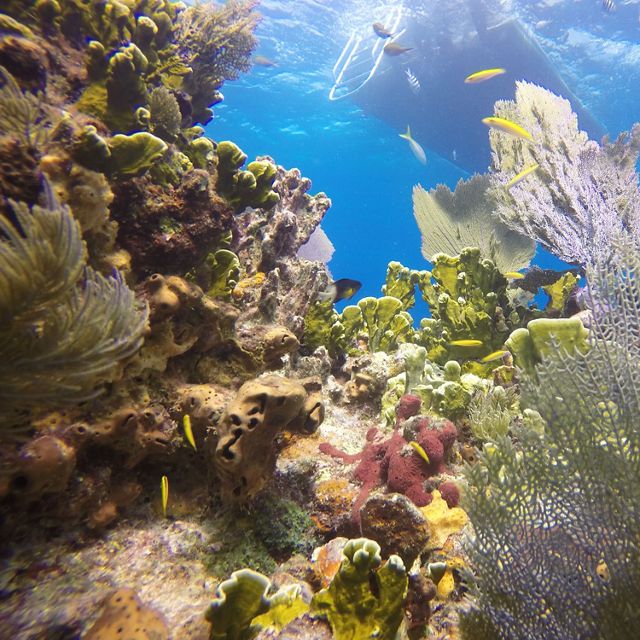
Protecting Our Oceans and Ourselves
More people rely on our ocean for food, energy, transport, recreation and other natural resources than any other time in history.

Climate Heroes: The Power of Trees
Trees are our climate superheroes! From Louisville, Kentucky, in the United States to St. Vincent and the Grenadines in the Caribbean, trees are playing critical roles in cleaning our air and improving our resilience in the face of climate change.
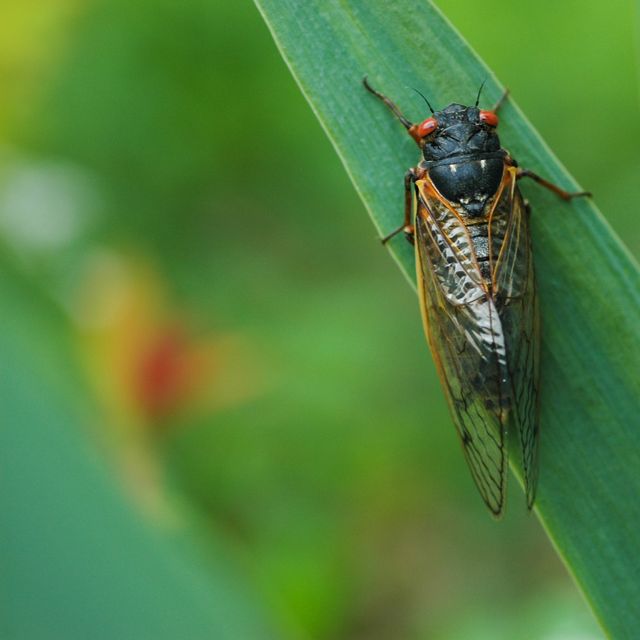
You’re the Scientist! Citizen Science, Frogs and Cicadas
The conservation community relies heavily on volunteers not only to restore natural areas but to help gauge the success of restoration efforts.

Changing Climate, Changing Cities
Get a front-row, ground-level seat to the challenges cities face as they confront this force of nature, and discover the solutions experts are promoting to mitigate it.
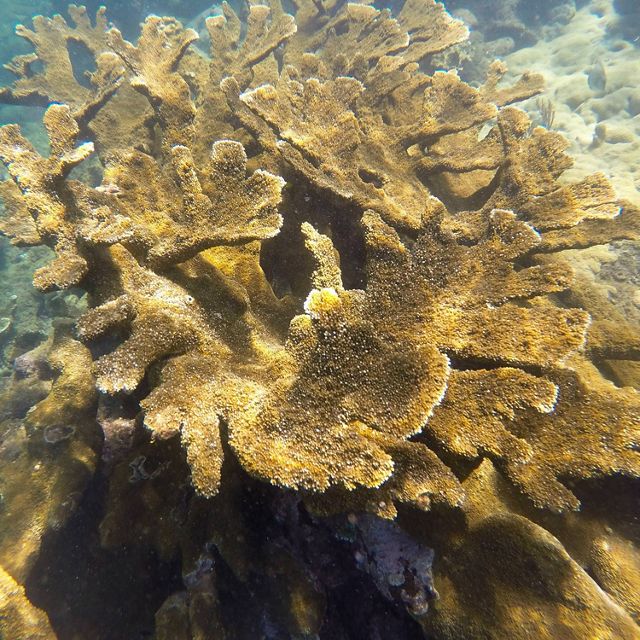
The Secret Life of Corals
Learn how fragile reefs are being damaged by human activity and climate change, and how scientists are developing ways to restore corals.
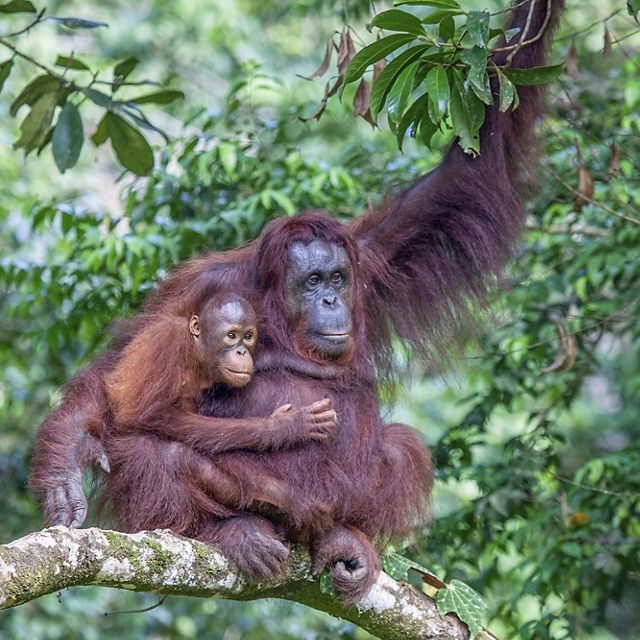
Borneo: The Symphony of the Rainforest
On this journey, we’ll learn how experts are using cutting-edge science to find out how healthy the rainforest is—and to discover where it needs some help!

View from a Canoe
Can you imagine a place with 100 million acres of forest and 30,000 miles of coastline? It exists. The Emerald Edge is home to the largest intact coastal temperate rainforest.

Wild Biomes: America’s Rainforests & Deserts
Two wildly different ecosystems, both dependent on the same precious resource: Water. On this virtual field trip, we’ll travel to Seattle and Arizona.

The Coral Reefs of Palau
Join our expert scientist, marine biologist Stephanie Wear, on a virtual field trip to the coral reefs of Palau where you'll explore amazing underwater cities.
.jpg?crop=669%2C0%2C2662%2C2662&wid=640&hei=640&scl=4.159375)
China’s Great Forests
Join our expert scientist Yue Wang, a conservation planning officer for The Nature Conservancy, on a virtual field trip across the world to two stunning provinces in China.

Powering the Planet: Renewable Energy
Join scientist Alex Wegmann as we embark on a Virtual Field Trip to explore a compelling question: How can we get the energy we need without harming nature?
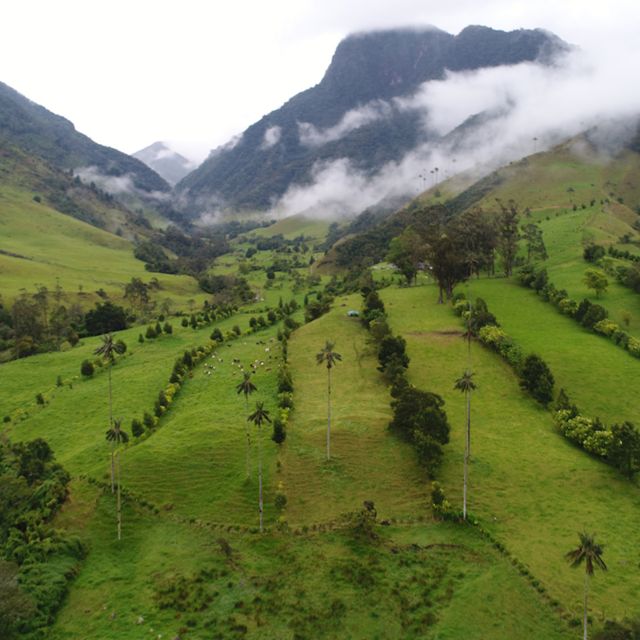
Journey of Water: Colombia’s Páramo
In this virtual field trip, we will explore the magical páramo ecosystem and the stunning mountain landscapes found just beyond the capital city of Bogotá.
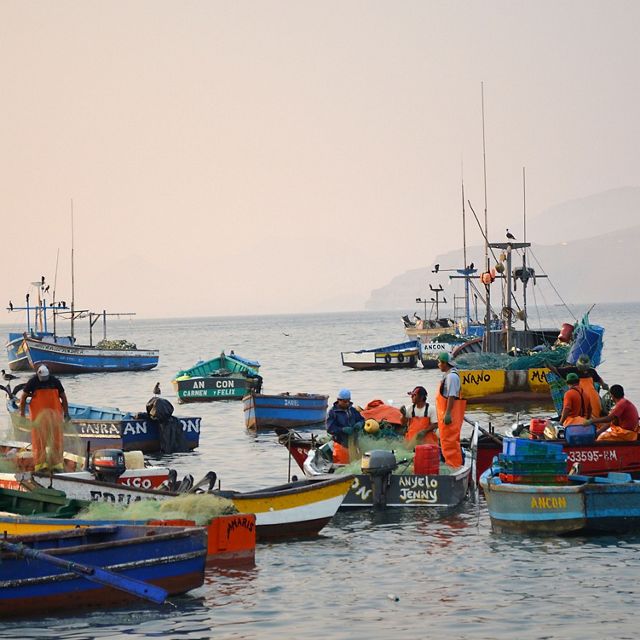
Peru: A Coastal Ecosystem
Join fisheries scientist Matias Caillaux to explore the Humboldt Current Ecosystem off the coast of Peru while learning about the area’s amazing diversity and productivity.
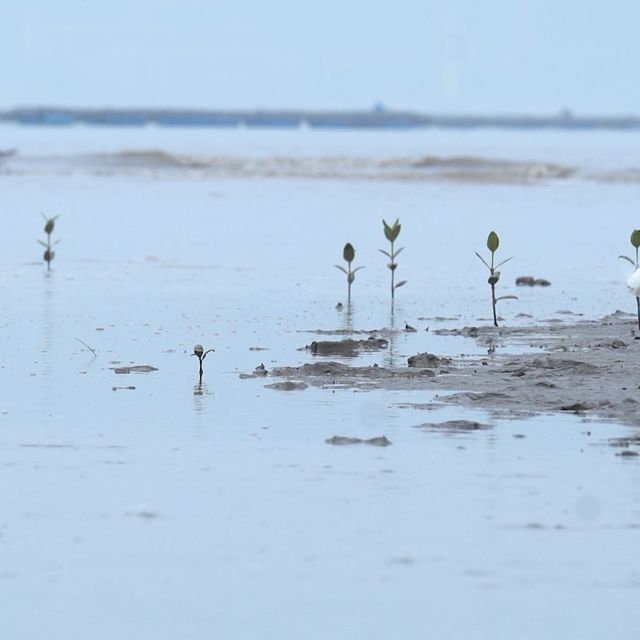
Ridge to Reef: A Virtual Field Trip to Hong Kong
The “Ridge to Reef” (R2R) concept is a holistic approach that takes into consideration all the environments within a watershed — from the top of the mountains down to the ocean — and shows that what happens on land affects what happens in the water.
Stay connected for the latest resources from Nature Lab
Don't miss new Nature Lab teaching guides and videos. Sign up to get the monthly Nature Lab newsletter with free environmental education materials for educators and families.
Explore Our Youth Curriculum
Access resources aligned to The Nature Conservancy’s research and designed specifically for a young audience and classroom use.

UN Tourism | Bringing the world closer
Share this content.
- Share this article on facebook
- Share this article on twitter
- Share this article on linkedin
A United Vision for Nature - 'Nature Positive' Report Marks New Collaborative Era in Travel & Tourism
- All Regions
- 22 Apr 2024
WTTC, UN Tourism and the Sustainable Hospitality Alliance join forces to support Nature Positive Tourism

The leading players of Travel & Tourism globally have published a landmark joint report setting out their joint plan to help halt and reverse biodiversity loss.
Launched on Earth Day 2024, "Nature Positive Travel & Tourism in Action" is the creation of the high-level 'Nature Positive Tourism Partnership, made up of the World Travel & Tourism Council ( WTTC ), the World Tourism Organization ( UN Tourism ) and the Sustainable Hospitality Alliance ( the Alliance ).
For years, UN Tourism has been at the forefront of integrating tourism into the broader UN biodiversity agenda, including supporting the work of the Secretariat of the Convention on Biological Diversity (CBD)
Developed in collaboration with specialist consultancy ANIMONDIAL, the report is the sector's pledge to support the implementation of the Kunming-Montreal Global Biodiversity Framework (GBF), the UN's Biodiversity Plan.
It presents more than 30 case studies of inspiring and progressive actions from around the world involving large and small businesses, national and local government agencies, civil society groups, and inter-sectoral partnerships.
By offering actionable guidance and insights, this report not only highlights the intrinsic link between biodiversity and tourism's resilience, but also empowers businesses to become stewards of nature.

Historic partnership for nature
Ms. Julia Simpson, WTTC President & CEO , said: "This historic partnership with Travel & Tourism heavyweights is a significant step in our collective journey towards a more sustainable and responsible sector. This report is not merely a publication but a movement towards integrating environmental stewardship into the core of travel experiences. As we celebrate Earth Day, let us heed the call to nurture and protect our destinations. Our sector's reliance on nature, coupled with our expertise in creating inspiring and memorable experiences, means we are ideally placed to be guardians of nature."
Mr. Zurab Pololikashvili, Secretary-General of UN Tourism , said: "For years, UN Tourism has been at the forefront of integrating tourism into the broader UN biodiversity agenda, including supporting the work of the Secretariat of the Convention on Biological Diversity (CBD). This pivotal new collaboration among key global players sets a robust framework for sustainable practices that not only drive significant impact but also exemplify the power of united efforts in conserving biodiversity. This report is a testimony to what we can achieve together for nature's preservation, inspiring a global movement towards more sustainable and resilient tourism."
Mr. Glenn Mandziuk, Sustainable Hotel Alliance CEO , said: "This report is a milestone for Travel and Tourism, representing our commitment as an industry to protect and conserve nature. The Alliance is proud to contribute to and collaborate on this insightful and action-orientated report which will bring tangible change to destinations around the world, supporting biodiversity. Nature underpins our society, economies and indeed our very existence. The hospitality industry is today a leader amongst industries in its Nature Positive approach and this report signifies how much our industry understands the true value of nature."
Expert-led coalition
Recognising that the sector has a critical role to play in protecting and conserving biodiversity, the Nature Positive Tourism approach is designed to be a touchstone for actionable change. It focuses on equipping the sector with the tools and insights needed to nurture and protect destinations upon which it depends.
The commitment of the Partnership to work towards "net positive for nature" draws on extensive consultation with experts from business, government, academia and civil society, including the International Union for Conservation of Nature (IUCN) and the World Commission on Protected Areas (WCPA).
The report, which follows the 2022 WTTC report "Nature Positive Travel & Tourism", includes practical frameworks and real-world examples that encourage both travel providers and travellers to embark on journeys that contribute to the conservation of our natural treasures.
Related links
- Download News Release on PDF
- Report “Nature Positive Travel & Tourism”
- UN Tourism Biodiversity
- Sustainable Hospitality Alliance
Related Content
Over 260 applications from 60+ countries: best tourism ..., un tourism puts spotlight on investments and empowermen..., un tourism calls for cross-cultural dialogue and climat..., un tourism and icca partner around sustainable developm....
Academia.edu no longer supports Internet Explorer.
To browse Academia.edu and the wider internet faster and more securely, please take a few seconds to upgrade your browser .
Enter the email address you signed up with and we'll email you a reset link.
- We're Hiring!
- Help Center

Land use changes in the environs of Moscow

Related Papers
Eurasian Geography and Economics
Grigory Ioffe
komal choudhary
This study illustrates the spatio-temporal dynamics of urban growth and land use changes in Samara city, Russia from 1975 to 2015. Landsat satellite imageries of five different time periods from 1975 to 2015 were acquired and quantify the changes with the help of ArcGIS 10.1 Software. By applying classification methods to the satellite images four main types of land use were extracted: water, built-up, forest and grassland. Then, the area coverage for all the land use types at different points in time were measured and coupled with population data. The results demonstrate that, over the entire study period, population was increased from 1146 thousand people to 1244 thousand from 1975 to 1990 but later on first reduce and then increase again, now 1173 thousand population. Builtup area is also change according to population. The present study revealed an increase in built-up by 37.01% from 1975 to 1995, than reduce -88.83% till 2005 and an increase by 39.16% from 2005 to 2015, along w...
Elena Milanova
Land use/Cover Change in Russia within the context of global challenges. The paper presents the results of a research project on Land Use/Cover Change (LUCC) in Russia in relations with global problems (climate change, environment and biodiversity degradation). The research was carried out at the Faculty of Geography, Moscow State University on the basis of the combination of remote sensing and in-field data of different spatial and temporal resolution. The original methodology of present-day landscape interpretation for land cover change study has been used. In Russia the major driver of land use/land cover change is agriculture. About twenty years ago the reforms of Russian agriculture were started. Agricultural lands in many regions were dramatically impacted by changed management practices, resulted in accelerated erosion and reduced biodiversity. Between the natural factors that shape agriculture in Russia, climate is the most important one. The study of long-term and short-ter...
Annals of The Association of American Geographers
Land use and land cover change is a complex process, driven by both natural and anthropogenic transformations (Fig. 1). In Russia, the major driver of land use / land cover change is agriculture. It has taken centuries of farming to create the existing spatial distribution of agricultural lands. Modernization of Russian agriculture started fifteen years ago. It has brought little change in land cover, except in the regions with marginal agriculture, where many fields were abandoned. However, in some regions, agricultural lands were dramatically impacted by changed management practices, resulting in accelerating erosion and reduced biodiversity. In other regions, federal support and private investments in the agricultural sector, especially those made by major oil and financial companies, has resulted in a certain land recovery. Between the natural factors that shape the agriculture in Russia, climate is the most important one. In the North European and most of the Asian part of the ...
Ekonomika poljoprivrede
Vasilii Erokhin
Journal of Rural Studies
judith pallot
In recent decades, Russia has experienced substantial transformations in agricultural land tenure. Post-Soviet reforms have shaped land distribution patterns but the impacts of these on agricultural use of land remain under-investigated. On a regional scale, there is still a knowledge gap in terms of knowing to what extent the variations in the compositions of agricultural land funds may be explained by changes in the acreage of other land categories. Using a case analysis of 82 of Russia’s territories from 2010 to 2018, the authors attempted to study the structural variations by picturing the compositions of regional land funds and mapping agricultural land distributions based on ranking “land activity”. Correlation analysis of centered log-ratio transformed compositional data revealed that in agriculture-oriented regions, the proportion of cropland was depressed by agriculture-to-urban and agriculture-to-industry land loss. In urbanized territories, the compositions of agricultura...
Open Geosciences
Alexey Naumov
Despite harsh climate, agriculture on the northern margins of Russia still remains the backbone of food security. Historically, in both regions studied in this article – the Republic of Karelia and the Republic of Sakha (Yakutia) – agricultural activities as dairy farming and even cropping were well adapted to local conditions including traditional activities such as horse breeding typical for Yakutia. Using three different sources of information – official statistics, expert interviews, and field observations – allowed us to draw a conclusion that there are both similarities and differences in agricultural development and land use of these two studied regions. The differences arise from agro-climate conditions, settlement history, specialization, and spatial pattern of economy. In both regions, farming is concentrated within the areas with most suitable natural conditions. Yet, even there, agricultural land use is shrinking, especially in Karelia. Both regions are prone to being af...
RELATED TOPICS
- We're Hiring!
- Help Center
- Find new research papers in:
- Health Sciences
- Earth Sciences
- Cognitive Science
- Mathematics
- Computer Science
- Academia ©2024

- Rivers and Lakes
- Severe Weather
- Fire Weather
- Long Range Forecasts
- Climate Prediction
- Space Weather
- Past Weather
- Heating/Cooling Days
- Monthly Temperatures
- Astronomical Data
- Beach Hazards
- Air Quality
- Safe Boating
- Rip Currents
- Thunderstorms
- Sun (Ultraviolet Radiation)
- Safety Campaigns
- Winter Weather
- Wireless Emergency Alerts
- Weather-Ready Nation
- Cooperative Observers
- Daily Briefing
- Damage/Fatality/Injury Statistics
- Forecast Models
- GIS Data Portal
- NOAA Weather Radio
- Publications
- SKYWARN Storm Spotters
- TsunamiReady
- Service Change Notices
- Be A Force of Nature
- NWS Education Home
- Pubs/Brochures/Booklets
- NWS Media Contacts
NWS All NOAA
- Organization
- Strategic Plan
- Commitment to Diversity
- For NWS Employees
- International
- National Centers
- Social Media
Privacy Policy
National Weather Service
National Headquarters
National Forecast Maps
National forecast chart.
High Resolution Version | Previous Days Weather Maps Animated Forecast Maps | Alaska Maps | Pacific Islands Map Ocean Maps | Legend | About These Maps
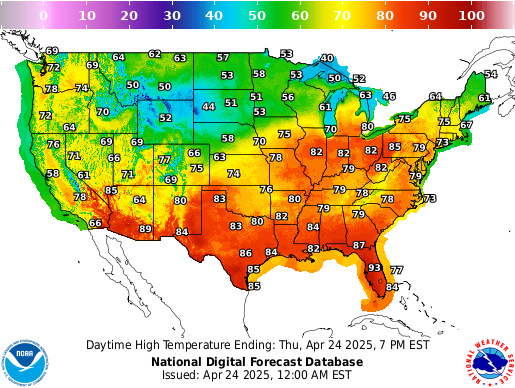
National Temperature
Alaska | Hawaii | Guam | Puerto Rico/Virgin Islands More from the National Digital Forecast Database
Short Range Forecasts
Short range forecast products depicting pressure patterns, circulation centers and fronts, and types and extent of precipitation.
12 Hour | 24 Hour | 36 Hour | 48 Hour
Medium Range Forecasts
Medium range forecast products depicting pressure patterns and circulation centers and fronts
Day 3 | Day 4 | Day 5 | Day 6
Precipitation Amounts
Quantitative precipitation forecasts.
Day 1 | Day 2 | Day 3
Surface Analysis
Highs, lows, fronts, troughs, outflow boundaries, squall lines, drylines for much of North America, the Western Atlantic and Eastern Pacific oceans, and the Gulf of Mexico.
Standard Size | High Resolution

Temperature
Maximum daytime or minimum overnight temperature in degrees Fahrenheit.
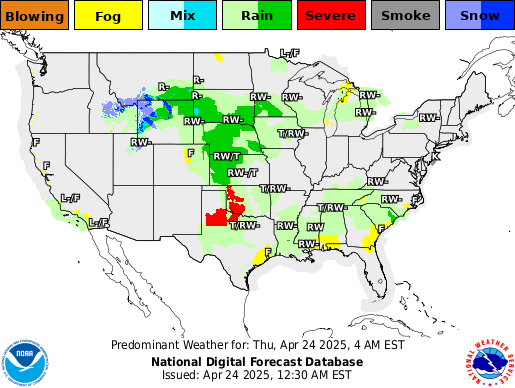
Predominant Weather
Expected weather (precipitating or non-precipitating) valid at the indicated hour. The weather element includes type, probability, and intensity information.

Wind Speed and Direction
Sustained wind speed (in knots) and expected wind direction (using 36 points of a compass) forecasts.
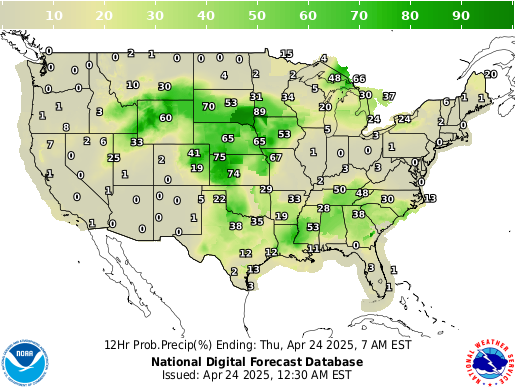
Chance of Precipitation
Likelihood, expressed as a percent, of a measurable precipitation event (1/100th of an inch).
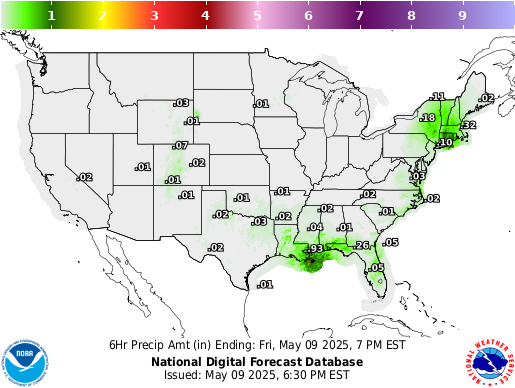
Precipitation Amount
Total amount of expected liquid precipitation.

Expected amount of opaque clouds (in percent) covering the sky.

Alaska Graphical Forecasts
Graphical forecasts from the National Digital Forecast Database for Alaska.

Hawaii Graphical Forecasts
Graphical forecasts from the National Digital Forecast Database for Hawaii.
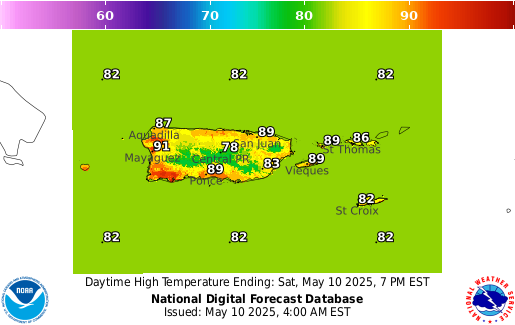
Puerto Rico Graphical Forecasts
Graphical forecasts from the National Digital Forecast Database for Puerto Rico and Virgin Islands.
ACTIVE ALERTS Warnings By State Excessive Rainfall and Winter Weather Forecasts River Flooding Latest Warnings Thunderstorm/Tornado Outlook Hurricanes Fire Weather Outlooks UV Alerts Drought Space Weather NOAA Weather Radio NWS CAP Feeds
PAST WEATHER Climate Monitoring Past Weather Monthly Temps Records Astronomical Data Certified Weather Data
CURRENT CONDITIONS Radar Climate Monitoring River Levels Observed Precipitation Surface Weather Upper Air Marine and Buoy Reports Snow Cover Satellite Space Weather International Observations
FORECAST Local Forecast International Forecasts Severe Weather Current Outlook Maps Drought Fire Weather Fronts/Precipitation Maps Current Graphical Forecast Maps Rivers Marine Offshore and High Seas Hurricanes Aviation Weather Climatic Outlook
INFORMATION CENTER Space Weather Daily Briefing Marine Climate Fire Weather Aviation Forecast Models Water GIS Cooperative Observers Storm Spotters Tsunami Warning System National Water Center International Weather
WEATHER SAFETY NOAA Weather Radio StormReady Heat Lightning Hurricanes Thunderstorms Tornadoes Rip Currents Floods Tsunamis TsunamiReady Winter Weather Ultra Violet Radiation Air Quality Damage/Fatality/Injury Statistics Red Cross Federal Emergency Management Agency (FEMA) Brochures Safe Boating
NEWS Newsroom Events Pubs/Brochures/Booklets
EDUCATION NWS Education Home Be A Force of Nature NOAA Education Resources Glossary JetStream NWS Training Portal NOAA Library For Students, Parents and Teachers Brochures
ABOUT Organization NWS Transformation Strategic Plan For NWS Employees International National Centers Products and Services Careers Glossary Contact Us Social Media
US Dept of Commerce National Oceanic and Atmospheric Administration National Weather Service 1325 East West Highway Silver Spring, MD 20910 Comments? Questions? Please Contact Us.
Analyzing spatiotemporal distribution patterns of metro ridership: Comparison between common-class and business-class carriage service
- Han, Chunyang
- Yang, Linchuan
- Liang, Jian
Understanding differentiated services is pivotal for enhancing the appeal and diversity of the metro system, yet this facet has received relatively scant attention in existing literature. To bridge this research gap, our analysis delves into the business-class services offered by the metro and compares them with the common-class offerings. First, we illustrate the spatial and temporal patterns of business- and common-class ridership across stations and hours. Second, we construct two-stage geographically weighted regression models to identify key determinants and their spatiotemporally heterogeneous effects, focusing on land-use patterns, demographic considerations, and intermodal transfer modes. Leveraging one-week smart card data collected in Shenzhen from May 13th to 17th, 2019, our findings underscore the following aspects: (1) Spatial and temporal variations in business-class ridership across stations are linked to diverse land-use configurations. (2) Bus-metro transfers, business establishments, medical facilities, and the proportion of young commuters contribute significantly to the business-class ridership. (3) The emergence of business-class trip is weakly associated with bike-sharing activities but has a strong correlation with bus transfers. (4) Business establishments and medical facilities exhibit nuanced impacts on business-class travel, with excessive aggregation leading to unintended consequences. These insights offer valuable policy implications for fostering the development of business-class services in the metro systems of other Chinese cities.
- Metro system;
- Differentiated service;
- Business-class ridership;
- Common-class ridership;
- Spatiotemporal pattern

Domestic vs. international travel: The pros and cons
International travel, cultural diversity, historical marvels, global perspectives, cost and logistics, jet lag and time zones, health and safety considerations, domestic travel, cost-effective, convenience and accessibility, diverse landscapes, familiarity and comfort.
Read more: Dreamy destinations in Asia for a romantic vacation
Limited cultural exposure
Potential for monotony.
Read more: This is how AI imagines world’s most beautiful temples
This will remain an eternal debate, wherein the answer lies in personal preferences, interests, and the type of experience one seeks. International travel offers a broad spectrum of cultural immersion and global exploration, albeit with higher costs and logistical complexities, whereas domestic travel provides convenience, familiarity, and cost-effectiveness, with the potential to uncover hidden gems within one's own country.
Ultimately, the ideal choice depends on the individual's goals and desires. Whether it's the allure of foreign cultures or the comfort of exploring familiar landscapes, both international and domestic travel offer unparalleled opportunities for discovery, adventure, and personal growth.

- Mobile Apps
- Subscribe Now

Secondary Menu
- Art & Leisure
- Classifieds
NEPA engaging Rock Community on wetlands tour to Mark International Day For Biodiversity

The National Environment and Planning Agency (NEPA) will mark International Day for Biological Diversity (IDB) with a field trip to the Winns Morass in Falmouth, Trelawny, for students and residents in and around the community of Rock on Tuesday, May 21.
IDB is being observed globally on May 22 under the theme: 'Be Part of the Plan', in keeping with the Convention on Biological Diversity (CBD) to which Jamaica has been a signatory since 1995.
Senior Public Education and Community Outreach Officer at NEPA, Ava Tomlinson, told JIS News that the decision was taken to observe IDB locally a day earlier, primarily to ensure participation by students and other residents in the wetlands tour.
Students from early childhood, primary and secondary institutions will be invited, and are expected to benefit from interactions with animals living in the wetlands and conservation rescue centre.
“We will have schools such as Smart Start, these are the babies from Rock, aged three to five years old, as well as the Falmouth Infant School. We will have primary school students from the Hague Primary School and secondary students from William Knibb High School and Holland High school. This is a part of the continuation of the public education efforts we have been making in the community of Rock. We have also invited residents to join us on the day,” Tomlinson said.
Headlines Delivered to Your Inbox
She added that the Winns Morass wetlands was chosen for the field trip due to its uniqueness.
“It has very healthy mangrove plants and, most significantly, it contributes to the preservation of the bioluminescence within Oyster Bay. When you touch the water at night and it glistens, this is because it has bioluminescent Phytoplankton which makes the unique area of Glistening Waters in Trelawny a special space,” she said.
Tomlinson further noted that the area is a critical habitat and nursery for wildlife such as the West Indian Whistling Duck, the Great Blue Heron, and the American crocodile, and serves as a space for commercial fishing.
The tour will be supported by school-focused initiatives such as the National Schools Environment Club Programme (NSECP), National Junior Environment Programme (NJEP) and the National Early Childhood Environmental Education participants in Trelawny.
Follow The Gleaner on X and Instagram @JamaicaGleaner and on Facebook @GleanerJamaica. Send us a message on WhatsApp at 1-876-499-0169 or email us at [email protected] or [email protected] .
- «Greater Mandeville Water Supply Improvement Project progressing as planned
- McNeill selected to represent PNP in Trelawny Northern, party stalwarts upset»
View the discussion thread.
Things to Do in Elektrostal, Russia - Elektrostal Attractions
Things to do in elektrostal.
- 5.0 of 5 bubbles
- 4.0 of 5 bubbles & up
- Good for a Rainy Day
- Good for Kids
- Good for Big Groups
- Adventurous
- Budget-friendly
- Hidden Gems
- Good for Couples
- Honeymoon spot
- Good for Adrenaline Seekers
- Things to do ranked using Tripadvisor data including reviews, ratings, photos, and popularity.

1. Electrostal History and Art Museum

2. Statue of Lenin

3. Park of Culture and Leisure
4. museum and exhibition center.

5. Museum of Labor Glory

7. Galereya Kino
8. viki cinema, 9. smokygrove.

10. Gandikap
11. papa lounge bar, 12. karaoke bar.
- Grand Rapids/Muskegon
- Saginaw/Bay City
- All Michigan
Equity officer booked trip to Europe, 80+ days of travel with Washtenaw County credit card
- Updated: May. 14, 2024, 12:27 p.m. |
- Published: May. 14, 2024, 12:05 p.m.

(Ryan Stanton | MLive file photo)
- Lucas Smolcic Larson | [email protected]
WASHTENAW COUNTY, MI – A top Washtenaw County official booked conference travel to Europe, reservations for a wellness retreat on the Caribbean coast and hotel stays exceeding $600 a night on at least four occasions using a government-issued credit card.
That’s according to an MLive/The Ann Arbor News review of more than two years of Mastercard statements and hundreds of pages of receipts associated with spending by county Racial Equity Officer Alize Asberry Payne.
More from The Ann Arbor News
- Saline students head to Chelsea’s Robin Hills Farm for 2024 prom
- See how the Michigan Rattler cocktail comes together at Lowertown Bar and Cafe
- PizzaPazza serves wood-fired Neapolitan-style pies in Ann Arbor’s Kerrytown
- Manchester Senior Cafe comes back stronger after COVID shut it down
- University Hospital to undergo $18M renovation to address capacity concerns
If you purchase a product or register for an account through a link on our site, we may receive compensation. By using this site, you consent to our User Agreement and agree that your clicks, interactions, and personal information may be collected, recorded, and/or stored by us and social media and other third-party partners in accordance with our Privacy Policy.
- Yekaterinburg
- Novosibirsk
- Vladivostok

- Tours to Russia
- Practicalities
- Russia in Lists
Rusmania • Deep into Russia

Transport in Zvenigorod
Zvenigorod is located in 50km from Moscow and has very good transport connection with Moscow.
Zvenigorod Railway Station

Zvenigorod Railway Station is located far from the city centre. To get to the centre from the railway station, take bus No. 23 or No. 51. Or take a taxi - it cannot cost more that RUB250.
Zvenigorod Bus Station
There is no bus station in Zvenigorod and buses from Moscow terminate in the city centre at what is known as the Mayakovsky Quarter bus stop, stopping at Ulitsa Proletarskaya on the way there.
Plan your next trip to Russia
Ready-to-book tours.
Your holiday in Russia starts here. Choose and book your tour to Russia.
REQUEST A CUSTOMISED TRIP
Looking for something unique? Create the trip of your dreams with the help of our experts.
trending now in US News

CNN political commentator, GOP adviser dead at 58

'Anxious' gambler, 72, says Atlantic City casino won't pay out...

Rudy Giuliani's birthday bash ends in chaos as guests scream and...

Sean 'Diddy' Combs' ex-assistant not surprised by video showing...

Mom left waiting hours for help after 911 call for home invasion:...

6-year-old girl bravely saves NYU Law commencement with...

Rep. Jasmine Crockett launches 'Clapback Collection' off Marjorie...

At least a dozen anti-Israel protesters arrested in NYC after...
Biden again omits free vacations at million dollar homes from ethics forms despite clarence thomas outcry.
- View Author Archive
- Get author RSS feed
Thanks for contacting us. We've received your submission.
WASHINGTON — President Biden failed again to note his free stays at the vacation homes of rich patrons on annual ethics forms made public this week — making the omission days after ProPublica was awarded a Pulitzer Prize for chronicling Supreme Court justices’ non-disclosures under the same transparency rule.
Biden took four vacations at the homes of wealthy supporters in 2023, none of which were listed as gifts on the forms signed by the president . The annual paperwork must be submitted by federal officeholders — including judges and presidents — under the Ethics in Government Act of 1978.
“If there’s a deliberate omission of a gift, an intentional lie, that can very well be prosecuted as a criminal offense,” said Richard Painter, who served as chief White House ethics lawyer under President George W. Bush.

“It just seems to me to be stupid to leave it off the form because everyone knows about [presidential] trips and everyone’s going to ask who paid,” added Painter, who ran unsuccessfully for Congress as a Democrat in 2018 and 2022.
“So you either have to pay for the house, make sure the owner is present or put it on the form. Those are your three options.”
Biden and his family began and ended 2023 with free stays over the New Year’s holiday at the beachfront St. Croix home of Bill and Connie Neville, which is typically listed as a VRBO rental.
Bill Neville is the founder of the US Viking software company, which makes an online content platform called ENPS marketed by The Associated Press and used by various news outlets.
Biden also enjoyed a six-day Thanksgiving stay at billionaire hedge fund founder David Rubenstein’s Nantucket compound last year and nine days in August at billionaire climate investor Tom Steyer’s waterfront Lake Tahoe retreat in Nevada.
Biden’s time at Rubenstein’s compound is believed to have been unpaid, though neither party has confirmed it.

The White House initially claimed that Biden would pay “fair market value” for Steyer’s home, resulting in a short-lived local investigation due to the moneyman’s lack of a rental permit. That probe was mysteriously dropped and the terms of the alleged rental have not been disclosed.
The homeowners are believed to have been present for none of the four trips, as has been the case for similar free stays spanning Biden’s more than three-year presidency and eight years as vice president.
First lady Jill Biden also scored tickets to cheer on her beloved Philadelphia Eagles in Super Bowl LVII in February 2023, for which she is not believed to have paid and which also were not disclosed.
Opinions vary on whether those items should have been listed, though Vice President Kamala Harris did disclose tickets provided by ESPN to December’s Celebration Bowl college football game between Harris’ alma mater Howard University and Florida A&M. The ducats cost $1,890, according to Harris’ disclosure.
Intentionally leaving gifts off the forms could put Biden or his staff in criminal jeopardy for making false statements — a crime punishable by up to five years in prison under 18 U.S. Code § 1001, Painter said.

In the case of Steyer’s home, “if somebody told the White House Counsel’s Office, which prepares the gift schedule, ‘That doesn’t need to go on there because the president paid for the trip’ and then the White House Counsel’s Office relies on that in drafting the … gift schedule, it is then given to the president and the president signs — whoever it was told the White House Counsel’s Office that doesn’t need to go on there because the president paid for the trip, if that person knew that was not true and knowingly told a lie to the White House Counsel’s Office, whoever that person is, they violated 18 United States Code 1001, the false statements statute,” said the ethics expert.
“If [Biden] knew the gift schedule was incomplete and someone told him, he would have the same liability.”
‘BILLIONAIRES WANT SOMETHING’: CRITICS ALLEGE DOUBLE STANDARD
At issue is different interpretations of a carveout that allows officials to not disclose “any food, lodging, or entertainment received as personal hospitality.”
Biden and Supreme Court justices Clarence Thomas and Samuel Alito, both of whose trips were subject to an investigative series by ProPublica, interpreted the policy as meaning they didn’t have to list the items.
Painter and other experts — including Walter Shaub, who led the Obama-era Office of Government Ethics, which administers the disclosure process for the executive branch — say that a homeowner has to be present for a free vacation to be exempted from disclosure, though others disagree.
“I have always been of the view that the exception cannot be used when the friend is not there, and I think arguments to the contrary make no sense,” Shaub previously told The Post. “It’s not the rich-friend-who-can-give-you-stuff exception. It’s supposed to apply to things like your friend’s kids’ wedding or a home cooked meal with your friend.”
Others, including Kedric Payne, general counsel of the Campaign Legal Center and a former Office of Congressional Ethics lawyer, hold a different view. Payne told The Post last year that he believes the executive branch “does not have a requirement that a host remain on the premises for the personal hospitality exemption to apply.”
Mark Paoletta, the general counsel of the White House budget office under President Donald Trump, said there clearly are two standards applied to scrutiny of such exceptions.
“This is another intentional refusal to disclose gifts by President Biden. His habit of taking over donors’ homes for vacations and not paying nor disclosing is consistent with his family’s long history of grift and corruption,” said Paoletta, a longtime friend and defender of Thomas, whose free travel with real estate billionaire Harlan Crow was the primary focus of ProPublica’s reporting.
Crow, who was present for some of Thomas’ travel, had no known business before the Supreme Court.
“Some liberal ethics experts have called Biden’s repeated omissions illegal and a potential criminal violation of law. And this year, Biden also failed to disclose Jill Biden’s use of the luxury box at the Super Bowl. They aren’t ashamed and don’t even bother hiding it because they know the liberal media won’t say a word,” Paoletta said.
“Where is the leftwing, billionaire-funded ProPublica, which was laughably awarded a Pulitzer for its dishonest agenda-driven ‘ethics’ reporting on conservative Supreme Court justices? Stone cold silent. They are completely fine with Biden’s actual, willful violations of the law. Double standard doesn’t begin to describe the hypocrisy on display.”
House Oversight Committee Chairman James Comer (R-Ky.) said there needs to be federal reform to heighten the consequences for gift omissions.

“The radical left’s silence on President Biden’s many ethics issues is deafening,” Comer said. “From President Biden’s involvement in his family’s influence peddling schemes, all the ‘loans’ the Bidens received from Democrat donors, to President Biden’s free vacation stays at his donors’ homes, it’s clear we need to reform federal ethics laws to provide greater transparency to the American people.”
The same law governs presidential and judicial ethics disclosures, though different entities enforce them.
Thomas said he was advised that the ethics law’s “personal hospitality” exception meant that he didn’t have to report the trips or reimburse for private jet flights. Reporting showed Crow also provided financial support to Thomas’ mother and great nephew.
Prominent Democrats — including Sen. Ed Markey (D-Mass.) and Rep. Alexandria Ocasio-Cortez (D-NY) — demanded that Thomas resign or be impeached and the US Judicial Conference last year tightened rules to specify that resorts didn’t count as personal residences exempt from reporting.
“This is beyond party or partisanship. This degree of corruption is shocking – almost cartoonish. Thomas must be impeached,” Ocasio-Cortez tweeted.
A White House official told The Post Thursday: “The President and First Lady did not have any required disclosures of gifts or travel reimbursements during the reporting period (January to December 2023). Under the ethics rules, gifts of personal hospitality from friends, such as food, lodging, and entertainment are not required to be listed on the report.”
But Painter, who frequently criticizes leaders of both parties on ethics issues, said he doesn’t think there needs to be additional legal reforms to clarify that such vacation stays must be listed.
“Most of these billionaires want something, other than just being able to be friends with famous people,” Painter said. “President Biden should set a good example by either paying for the house or fixing those forms.”
Share this article:

Advertisement

IMAGES
VIDEO
COMMENTS
TRIPs & Biodiversity. #3/2005 #1/ 2004. It appears that intellectual property rights (IPRs) applied on biodiversity, which are protected by the WTO TRIPs agreement (Trade-Related Aspects of Intellectual Property Rights), and biodiversity objectives that are covered by the Convention on Biological Diversity, contradict each other on most accounts.
Article 27.3b, traditional knowledge, biodiversity. The TRIPS Agreement requires a review of Article 27.3 (b) which deals with patentability or non-patentability of plant and animal inventions, and the protection of plant varieties. Paragraph 19 of the 2001 Doha Declaration has broadened the discussion.
Article 27.3(b) of TRIPS allows members to exclude from patentability the following: plants and animals other than micro-organisms; and. essentially biological processes for the production of plants or animals other than non-biological and microbi-ological processes. However, members shall provide for the protection of plant varieties either by ...
Title TRIPS and biodiversity : the threat and responses : a third-world view / Singh Nijar, Gurdial. Author Singh Nijar, Gurdial, author. Note Ordered from the publisher, Third World Network, November 2004; $6.00 USD. This booklet was produced by the Institute for Agriculture and Trade Policy with support from the Trade Research Consortium (TRC ...
Abstract. The relationship between the Trade-Related Aspects of Intellectual Property Rights Agreement (TRIPs) and the Convention on Biological Diversity (CBD) remains disputed. Relevant to the debate are developing countries, who hold a vast majority of the world's biological resources yet have traditionally lacked the enforcement mechanisms ...
TRIPS and biodiversity: a gender perspective 59 knowledge of growing conditions and the nutritional characteristics of various species is an essential basis for seed selection and plant breeding. In many societies, it is women who are mainly responsible for this, as well as for seed exchange and preservation of local biodiversity (Rani and
The TRIPS and Convention on Biological Diversity (CBD) with mutually conflicting approaches are now shaping the domestic regimes of member states with respect to biological resources. While the TRIPS provides for allowing patents on biological materials and associated indigenous knowledge, the CBD acknowledges that local communities have rights ...
biodiversity, and lays down the basic elements for access to biodiversity resources and associated knowledge systems. The TRIPs Agreement obliges party states to modify their national IPR regimes to meet much-enhanced international standards, which could have significant implications for biodiversity and the associated knowledge systems.
TRIPs and Biodiversity: The Threat and Responses : a Third World View. Gurdial Singh Nijar. Third World Network, 1996 - Agreement on Trade-Related Aspects of Intellectual Property Rights - 37 pages. From inside the book . Contents. Introduction . 1: Dealing with the Implications . 18:
TRIPS and biodiversity: A gender perspective. Gene Campaign is a movement involving organisations across Asia, working towards food and livelihood security for rural and tribal communities. It is deeply concerned about the negative impacts of privatisation on genetic resources through patenting and intellectual property rights.
TRIPS and biodiversity: A gender perspective. July 2004. Gender and Development 12 (2):58-65. DOI: 10.1080/13552070412331332210. Authors: Suman Sahai. Gene Campaign. To read the full-text of this ...
CBD and the TRIPS Agreement respectively. These sections highlight the IPR related aspects of the CBD, and the biodiversity related aspects of TRIPS. The analysis in these sections is drawn together in Part III, which summarises the most important issues arising from the substantive linkages between the CBD's objectives, IPRs and the TRIPS ...
Abstract. In comparison with industrialised countries, agriculture in developing countries accounts for a substantial share of GDP and involves a substantial sector of small-holders and traditional agriculturalists. In view of these differences, the biotechnology clause of Article 27.3.b TRIPS with its requirement of plant variety protection ...
The Convention on Biological Diversity (CBD) and the Agreement on Trade-Related Aspects of Intellectual Property Rights (TRIPS) of the World Trade Organization (WTO) have significant implications for the nexus of Intellectual Property Rights (IPRs), biodiversity, and associated knowledge systems.CBD requires parties to safeguard biodiversity and the traditions and knowledge of the indigenous ...
[TRIPS] prevents government action for sharing the benefits of the use of biodiversity and ensuring such utilization is sustainable and conserves biodiversity in an equitable manner since it obliges states to protect patent monopolies. For most people, sharing biological heritage is the only legitimate way of sharing benefits equitably.
The last few years have seen a range of significant developments related to intellectual property rights (IPRs) and biodiversity. At least two major international agreements, both legally binding, deal with this issue: the Convention on Biological Diversity (CBD) and the Agreement on Trade-Related Aspects of Intellectual Property Rights (TRIPs ...
Gene Campaign is a movement involving organisations across Asia, working towards food and livelihood security for rural and tribal communities. It is deeply concerned about the negative impacts of privatisation on genetic resources through patenting and intellectual property rights. Biological resources are the mainstay of the livelihoods and ...
Explore the World with Virtual Field Trips. Designed for ages 9-15 but customizable for all ages, virtual field trips allow students to travel the world and explore natural environments without leaving the classroom. Each virtual field trip contains a video, teacher guide and student activities.
The Biodiversity Act of 2002 in India stipulates that indigenous tribes must give their prior informed consent before accessing and utilizing a bioresource. It also establishes a legal framework ...
Recognising that the sector has a critical role to play in protecting and conserving biodiversity, the Nature Positive Tourism approach is designed to be a touchstone for actionable change. It focuses on equipping the sector with the tools and insights needed to nurture and protect destinations upon which it depends.
Enter the email address you signed up with and we'll email you a reset link.
National Weather Maps. Surface Analysis. Highs, lows, fronts, troughs, outflow boundaries, squall lines, drylines for much of North America, the Western Atlantic and Eastern Pacific oceans, and the Gulf of Mexico.
Understanding differentiated services is pivotal for enhancing the appeal and diversity of the metro system, yet this facet has received relatively scant attention in existing literature. To bridge this research gap, our analysis delves into the business-class services offered by the metro and compares them with the common-class offerings. First, we illustrate the spatial and temporal patterns ...
Cultural diversity International travel allows you to experience a vast array of cultures, traditions, and histories. Exploring foreign destinations allow travellers to immerse themselves in ...
The National Environment and Planning Agency (NEPA) will mark International Day for Biological Diversity (IDB) with a field trip to the Winns Morass in Falmouth, Trelawny, for students and residents in and around the community of Rock on Tuesday, May 21.
10. Gandikap. 11. Papa Lounge Bar. 12. Karaoke Bar. What are the top attractions to visit in Elektrostal? Things to Do in Elektrostal, Russia: See Tripadvisor's 801 traveler reviews and photos of Elektrostal tourist attractions. Find what to do today, this weekend, or in May.
WASHTENAW COUNTY, MI - A top Washtenaw County official booked conference travel to Europe, reservations for a wellness retreat on the Caribbean coast and hotel stays exceeding $600 a night on at ...
The duration of the trip is about 1h20. Elektrichkas leave from Moscow's Belorussku Railway Station (Белорусский вокзал). There are three direct bus routes from Moscow to Zvenigorod: 452 - departing from Kuntsevskaya Metro Station (exit closer to the last carrige of metro if you come from the city centre). Duration about 50 ...
A teenager who travelled solo to several countries on a budget of just 11,500 yuan (US$1,600) has been besieged by sex-for-sale rumours spread by people who refused to accept her success. The ...
President Biden failed to include his free vacations at the homes of rich patrons in his annual ethics forms. REUTERS/Elizabeth Frantz "It just seems to me to be stupid to leave it off the form ...